Sites: news | india | latam | brasil | indonesia
Feeds: news | india | latam | brasil | indonesia
topic: Extreme Weather
Social media activity version | Lean version
From polling stations to weather stations, the heat is on in India (commentary)
- Parts of India are facing a heatwave, for which the heat in the state of Kerala is a curtain raiser. Kerala experienced its first recorded heatwave amid the ongoing election campaign.
- Heatwaves, droughts and floods do not distinguish along political lines. If the destruction is across board, the mitigating action also has to be across political lines, writes Mongabay-India’s Managing Editor, S. Gopikrishna Warrier, in this commentary.
- Climate change poses economic, social and political challenges, influencing election discourse and policy agendas.
- This post is a commentary. The views expressed are those of the author, not necessarily Mongabay.
Panama delays promised relocation of sinking island community
- The government of Panama continues to delay the process of relocating almost 1,300 Indigenous Guna inhabitants from an island experiencing rising sea levels due to climate change.
- The lack of space on the tiny Caribbean island of Gardi Sugdub means there’s no room to relocate, and a new site on the mainland for the community has been in the works since 2019.
- But plans for the relocation have been repeatedly delayed due to administrative issues, previous COVID-19 restrictions and poor budgeting, leaving residents skeptical that government promises will be upheld.
- Members of this fishing community have also expressed concern about the relocation site, which is a 30-minute walk from the coast, and about the design of the new homes, for which the government didn’t seek Guna input.
Faced with an extreme future, one Colombian island struggles to rebuild
- In 2020, Hurricane Iota destroyed most of the housing and infrastructure on the Island of Providencia, in Colombia’s Caribbean archipelago of San Andres.
- Although the government sent aid and rebuilt homes, communities complained they were left out of the consultation process and that the reconstruction had been poorly done, without addressing the island’s increased vulnerability to climate change.
- Locals sued the government, obtaining a reopening of consultations, which the new left-wing government has agreed must reach a solution that accords with the islanders’ traditional customs.
- More than 700 islands in the Caribbean could be increasingly exposed to more extreme weather, as climate change threatens to make events such as hurricanes more destructive.
Rainwater reserves a tenuous lifeline for Sumatran community amid punishing dry season
- Kuala Selat village lies on the coast of Indragiri Hilir district on the Indonesian island of Sumatra.
- In the first half of the year, residents of the village arrange buckets and drums to collect rainwater to meet their daily needs.
- They will then stockpile water to last through the dry months from June-September, but a longer dry spell has led to an acute shortage of water.
- Residents say they believe the water crisis in the village was linked to bouts of diarrhea, and that many fled the village during an outbreak.
As fires ravaged Indonesia in 2023, some positive trends emerged, data show
- Indonesia’s 2023 fire season saw 1.16 million hectares (2.87 million acres) of land and forest go up in flames, and while this was five times higher than in 2022, experts highlight a positive trend.
- The fires were exacerbated by an intense El Niño weather system, unlike in 2022; the last time similar conditions prevailed, in 2019, the area affected by fires was much larger, suggesting fire mitigation efforts may be working.
- Most of the burning occurred in scrubland and areas of degraded forest rather than in intact forests, meaning greenhouse gas emissions from the burning were also much lower than in 2023.
- But a worrying trend highlighted by the numbers is that severe fires are now occurring in four-year cycles, intensified and exacerbated by the impacts of a changing climate.
We need rapid response support for Indigenous peoples in the face of growing extreme weather events (commentary)
- Climate change can sometimes feel distant and intangible, but the increasingly frequent extreme weather events in tropical forest regions like the Amazon and Congo Basin are already having very real-world impacts on Indigenous and other local communities in these areas.
- While Indigenous and grassroots organizations are often the first responders and are best placed to know the needs of their communities, they face huge challenges in accessing heavily bureaucratic disaster response funding.
- This is why we are calling for the establishment of a dedicated fit-for-purpose rapid response fund for them to be able to respond and recover from such events.
- This post is a commentary. The views expressed are those of the author, not necessarily Mongabay.
Agroforestry project sows seeds of hope in drought-hit Honduras
- In response to longer and more intense droughts, Indigenous Tolupan farmers in Honduras are turning to agroforestry and agroecology strategies to adapt to the changing climate.
- The strategies include diversifying their crops, building water storage systems, introducing methods to better conserve water in the soil, and building up banks of native seeds.
- Although Honduras wasn’t among the 22 countries that declared a drought emergency in 2022 and 2023, severe heat waves and El Niño events are hitting harvests hard, leading to an exodus of young people out of rural areas.
- Locals participating in the adaptation initiative say it’s starting to bear fruit and give them hope — a precious resource in a dry land.
‘Another catastrophe’: Flooding destroys Indigenous agroforestry projects in Peru’s Amazon
- Heavy rains likely caused by El Niño began flooding Peru’s Ene River at the beginning of March, with waters reaching around 2 feet high and spreading across 5,000 hectares (12,355 acres) of land occupied by around 300 Indigenous Asháninka families.
- Families in five Asháninka communities lost their homes as well as years of work on successful and sustainable agroforestry projects for cacao, coffee and timber, among other products.
- The flood waters have only recently receded, so a long-term or even mid-term plan for recovering their agroforestry projects hasn’t been developed yet.
- The Asháninka have faced many other setbacks over the years, from drug trafficking groups to unsustainable development projects, but have often overcome them to defend their territory. This flood marks the latest setback.
Brazilian youngsters discuss how they are tackling the climate emergency
- Affected by drought, pollution, high waters and floods, young people from different Brazilian states describe how climate change is impacting their routines and causing illness, malnutrition, displacement and school disruption.
- According to a UNICEF report, 2 billion children and adolescents in the world are exposed to risks arising from the climate emergency; in Brazil, there are 40 million affected children and adolescents — 60% of Brazilians under 18.
- According to experts, the climate crisis is a crisis of the rights of children and adolescents, as it affects everything from the right to decent housing and health care to education and food, leading to problems in child development and learning abilities.
Studies still uncovering true extent of 2019-20 Australia wildfire catastrophe
- Australia’s 2019-20 bushfires burned with unprecedented intensity through a total of 24 million hectares (59 million acres), an area the size of the U.K.
- New research shows total costs incurred to the tourism industry from that single bushfire season may be 61% higher than previously calculated.
- Up to 1.5 billion wild animals may have perished in the fires, and new research is uncovering the cost to individual species as a result of the fires.
- One study published shows 15% of all known roost locations of the gray-headed flying fox, Australia’s largest bat species, may have been directly impacted by the fires.
Study on Brazilian heat wave deaths shows gender & racial disparities
- A new study estimates that the deaths of nearly 50,000 people in Brazil in recent decades could be attributed to the occurrence of heat waves, and it points out that these extreme events have become increasingly frequent.
- The paper reveals that Blacks, Browns, females, older adults and those with lower educational levels are the most affected population subgroups, suggesting that the impacts of heat waves are felt unevenly, thus exposing socioeconomic inequalities.
- The researchers analyzed data from 14 metropolitan regions with a population of 74 million people, representing nearly one-third of Brazil’s population.
- This research is important because it joins others in analyzing racial and gender dimensions of the populations most vulnerable to extreme events, the scientific coordinator at Iyaleta Research Association says.
Sumatra firefighters on alert as burning heralds start of Riau dry season
- On the northeast coast of Indonesia’s Sumatra Island, the first of two annual dry seasons led to a spike in wildfires in some peatland areas in February.
- In the week ending March 2, Indonesian peatland NGO Pantau Gambut said 34 hotspots, possibly fires, were identified by satellite on peatlands in Riau province.
- Emergency services in the province have been concentrated to the east of the port city of Dumai, where a fire started in the concession of a palm oil company, according to local authorities.
In climate-related flooding, a Ugandan river turns poisonous
- Uganda’s Nyamwamba river, in the Rwenzori Mountains, has begun to flood catastrophically in recent years, partly due to climate change.
- Along the river are copper tailings pools from an old Canadian mining operation, which are becoming increasingly eroded by the flooding.
- According to a series of studies, these tailings have been washing into the water supply and soil of the Nyamwamba River Basin, contaminating human tissue, food and water with deadly heavy metals.
- Cancer rates are higher than normal near the tailings pools, and scientists fear that as the flooding continues to worsen, so will the health crisis.
As lightning strike fatalities increase, Bangladesh still has no reliable preventive measures
- Between 2011 and 2020, lightning strikes claimed the lives of 2,164 people, or nearly four people every week, in Bangladesh, according to the country’s disaster management department. However, a Bangladeshi NGO reports at least a thousand more lightning related fatalities between 2010 and 2021.
- Researchers linked the increased frequency of lightning with climate change; as for the increased death toll, they blamed the government’s inefficient protection measures, including the lack of tall trees.
- To reduce the number of fatalities, the government has started working on long-term solutions, such as installing lightning arresters and growing palm trees. Nevertheless, a significant sum of money is being squandered and nothing functions as expected, say experts.
Climate change brings a river’s wrath down on western Uganda
- Since the 1960s, Uganda’s climate has warmed by an average of 1.3°C (2.3°F).
- The warming is partly responsible for an increasing number of catastrophic floods on the Nyamwamba River, in western Uganda’s Rwenzori Mountains.
- In 2020 alone, 173,000 people were affected by flooding in Kasese district, when 25,000 houses were destroyed.
- Many of those rendered homeless by the floods continue to languish in temporary housing camps four years on.
Harsh dry season sours harvest prospects for Java coffee farmers
- Indonesia is the world’s fourth-largest producer of coffee, after Brazil, Vietnam and Colombia, but the archipelago’s farmers are less productive than their competitors.
- In East Java province, farmers have seen yields plummet as a protracted water deficit shrinks fruit and introduces pests.
- Total output is expected to drop by more than 20% this season, while increasingly frequent extreme weather may pose challenges to the viability of some smallholders in lowland areas of Indonesia.
Freeze on Russian collaboration disrupts urgently needed permafrost data flow
- Accelerating Arctic warming threatens to thaw more and more carbon-rich permafrost and release vast amounts of greenhouse gases into the Earth’s atmosphere, but scientists don’t know when such a tipping point event might occur.
- The potential for large and abrupt permafrost emissions adds urgency to better understanding the factors that could turn permafrost from a carbon sink into a carbon source.
- However, more than half of all Arctic permafrost lies under Russian soil, and a two-year freeze on collaborations between Russian scientists and the international scientific community — prompted by the Russian invasion of Ukraine on Feb. 24, 2022 — is disrupting data flows and hamstringing the polar research community.
- Despite an uncertain geopolitical landscape, scientists are determined to close the data gap with work-arounds such as pivoting to “proxy” field sites, ramping up remote sensing with AI, and mining archived data for new insights. But reintegrating Russian research with other Arctic research is a priority of the scientific community.
As climate disasters claim their children, Bangladeshi mothers seek safety in bigger families
- Climate change is exacerbating child mortality in flood-prone areas of Bangladesh, prompting mothers to have larger families as a response to the fear of losing children to disasters.
- Studies indicate an 8% surge in infant mortality risk in flood-prone regions, resulting in more than 150,000 lives lost between 1988 and 2017.
- While Bangladesh has seen improvements in disaster management, reduced cyclone deaths, and progress in health for mothers and children, climate change poses new threats, especially to vulnerable coastal communities lacking adequate protection.
- A National Adaptation Plan offers solutions such as water conservation and livelihood opportunities, but challenges like funding, coordination and transparency need attention for effective implementation, experts say.
The new Arctic: Amid record heat, ecosystems morph and wildlife struggle
- Every species of animal and plant that lives or breeds in the Arctic is experiencing dramatic change. As the polar region warms, species endure extreme weather, shrinking and altered habitat, decreased food availability, and competition from invading southern species.
- A wide array of Arctic organisms that rely on sea ice to feed or breed during some or all of their life cycles are threatened by melt: Over the past 40 years, the Arctic Ocean has lost about 75% of its sea ice volume, as measured at the end of the summer melt season. This translates into a loss of sea ice extent and thickness by half on average.
- Researchers note that the rate of change is accelerating at sea and on land. While species can adapt over time, Arctic ecosystem alterations are too rapid for many animals to adapt, making it difficult to guess which species will prevail, which will perish, and where.
- The only thing that could limit future extinctions, researchers say, is to quickly stop burning fossil fuels, the main driver of climate change.
Maluku farmers sweat El Niño drought as Indonesia rice prices surge
- Rice prices surged across Indonesia during the second half of 2023 as the effects of El Niño led to widespread crop failures.
- In December, President Joko Widodo ordered military personnel to help farmers plant rice in a bid to boost domestic production, and curb food price inflation.
- On Buru Island, Mongabay Indonesia spoke with farmers who described risks of conflict as water scarcity forced farmers to queue for access to water.
Java’s crumbling coastline and rising tide swamp jasmine flower trade
- Growers of jasmine flowers in lowland areas of Indonesia’s Central Java province are vulnerable to coastal erosion and rising sea levels.
- Research published in 2022 showed Central Java’s Semarang was among the fastest-sinking major cities in the world.
- Jasmine grower Sobirin has altered his home on three occasions since 2010, raising the floor to adapt to increasing tidal surges.
2023 fires increase fivefold in Indonesia amid El Niño
- Nearly 1 million hectares (2.47 million acres, an area 15 times the size of Jakarta) burned in Indonesia between January and October 2023, according to environment and forest ministry data; El Niño and burning for new plantations contributed to this.
- 2023 was the worst fire season since 2019, when that year’s El Niño brought a prolonged dry season and fires so severe, they sent billowing smoke across Malaysia and Singapore.
- In the absence of local jobs, some people burn abandoned farmlands and turn them into new plantations as a way to make a living and survive.
As Sri Lanka floods swell with climate change, so does human-crocodile conflict
- Sri Lanka is among the countries most vulnerable to climate change, with long drought spells, receiving intense rain during a shorter period with a marked increase in flood events.
- During flooding, crocodiles inhabiting rivers tend to reach land and move closer to human settlements, increasing the risk of encounters with people.
- The Nilwala River flows through southern Sri Lanka and recent flood events have increased croc encounters with humans in the Matara district and escalated threats to human safety, resulting in disaster management responses.
- During recent flooding events, no serious incidents linked to crocodiles were reported, but wildlife officials had to chase crocs away from riverbanks, highlighting the need for an immediate and durable solution for the human-crocodile conflict around the Nilwala River area.
Salmon and other migratory fish play crucial role in delivering nutrients
- Pacific salmon can play a key role in transporting nutrients from marine to freshwater and terrestrial ecosystems.
- In the past, Pacific salmon and other anadromous fish that spawn in freshwater and spend part of their life in the ocean likely played a much larger role in global nutrient cycles, scientists find.
- But today, many populations of Pacific salmon and other anadromous fish are under pressure from habitat loss, overfishing, climate change, dams and other pressures that have greatly reduced their numbers, weight and ability to migrate freely.
- Population declines could further curtail their role in global nutrient transport in future, with increasing consequences, especially for nutrient-poor ecosystems that have relied in the past on migratory fish for significant nutrient additions.
Detailed NASA analysis finds Earth and Amazon in deep climate trouble
- A NASA study analyzed the future action of six climate variables in all the world’s regions — air temperature, precipitation, relative humidity, short- and long wave solar radiation and wind speed — if Earth’s average temperature reaches 2° Celsius (3.6° Fahrenheit) above preindustrial levels, which could occur by 2040 if emissions keep rising at current rates.
- The authors used advanced statistical techniques to downscale climate models at a resolution eight times greater than most previous models. This allows for identification of climate variations on a daily basis across the world, something essential since climate impacts unfold gradually, rather than as upheavals.
- The study found that the Amazon will be the area with the greatest reduction in relative humidity. An analysis by the Brazilian space agency INPE showed that some parts of this rainforest biome have already reached maximum temperatures of more than 3°C (5.4°F) over 1960 levels.
- Regardless of warnings from science and Indigenous peoples of the existential threat posed by climate change, the world’s largest fossil fuel producers, largely with government consent, plan to further expand fossil fuel exploration, says a U.N. report. That’s despite a COP28 climate summit deal “transitioning away from fossil fuels.”
Causeway threatens mangroves that Philippine fishers planted as typhoon shield
- The city of Tacloban in the central Philippines was ground zero for Typhoon Haiyan, one of the most powerful tropical cyclones ever recorded and the deadliest in the Philippines’ modern record.
- A decade after the storm, the city is moving forward with controversial plans to build a road embankment and land reclamation project that proponents say will help protect the city from storm surges.
- Opponents of the plan say it threatens local fisheries, will disrupt natural storm protection measures like mangroves, and is poorly designed as a barrier against storms.
- The plan will also result in the relocation of a coastal village of 500 households, who have been active stewards of the bay’s mangrove forests.
Salty wells and lost land: Climate and erosion take their toll in Sulawesi
- Coastal erosion on the west coast of Indonesia’s Sulawesi Island is so advanced that seawater has penetrated the groundwater supply that tens of thousands use for drinking water.
- The communities have yet to be served by utility water provision, so families are resorting to costly supplies of water from private distributors.
- Research shows that rising seas and more frequent and powerful storms will accelerate coastal abrasion, raising burdens shouldered by the world’s coastal communities.
Last of the reef netters: An Indigenous, sustainable salmon fishery
- Reef net fishing is an ancient, sustainable salmon-harvesting technique created and perfected by the Lummi and other Coast Salish Indigenous people over a millennium.
- Rather than chasing the fish, this technique uses ropes to create an artificial reef that channels fish toward a net stretched between two anchored boats. Fishers observe the water and pull in the net at the right moment, intercepting salmon as they migrate from the Pacific Ocean to the Fraser River near present-day Washington state and British Columbia.
- Colonialism, government policies, habitat destruction, and declining salmon populations have separated tribes from this tradition. Today, only 12 reef net permits exist, with just one belonging to the Lummi Nation.
- Many tribal members hope to revive reef net fishing to restore their cultural identity and a sustainable salmon harvest but face difficulties balancing economic realities with preserving what the Lummi consider a sacred heritage.
Fish out of water: North American drought bakes salmon
- An unprecedented drought across much of British Columbia, Canada, and Washington and Oregon, U.S., during the summer and fall months of June through October could have dire impacts on Pacific salmon populations, biologists warn.
- Low water levels in streams and rivers combined with higher water temperatures can kill juvenile salmon and make it difficult for adults to swim upriver to their spawning grounds.
- Experts say relieving other pressures on Pacific salmon and restoring habitat are the best ways to build their resiliency to drought and other impacts of climate change.
Battling desertification: Bringing soil back to life in semiarid Spain
- Southeastern Spain is experiencing the northward advance of the Sahara Desert, leading to declining rainfall, soil degradation, and climate change-induced droughts, threatening agricultural lands that have been farmed for many centuries.
- Local farmers recently began adopting regenerative agriculture practices to better withstand long, persistent droughts punctuated by torrential rains and subsequent runoff.
- Many farmers in the region have formed a collaborative group called Alvelal to address encroaching desertification, depopulation, and the lack of opportunities for youth.
- Alvelal members manage more than 15,000 hectares (37,000 acres) of farmland using regenerative agriculture techniques and aim to expand further, conserving more farmland against the onslaught of climate change, while restoring natural corridors and promoting biodiversity.
Record North Atlantic heat sees phytoplankton decline, fish shift to Arctic
- Scientists warn that record-high sea surface temperatures in the North Atlantic Ocean this year are having consequences for sea life.
- As marine heat waves there have worsened over the years, populations of phytoplankton, the base of the oceanic food chain, have declined in the Eastern North Atlantic.
- With experts predicting more heat anomalies to come, North Atlantic fish species are moving northward into the Arctic Ocean in search of cooler waters, creating competition risks with Arctic endemic species and possibly destabilizing the entire marine food web in the region.
- Lengthening and intensifying marine heat waves around the globe are becoming a major concern for scientists, who warn that the world will see even greater disruptions to ocean food chains and vital fisheries, unless fossil fuel burning is curtailed.
Kenya’s Lake Victoria floods leave orphaned children to run their households
- Beginning in 2019, devastating floods on the shores of Kenya’s Lake Victoria have inundated homes, displaced families and left some orphaned children in charge of caring for their siblings and running the household.
- Many families continue to live in makeshift camps, hoping to rebuild and renew their lives; the effects of the flooding have been particularly harsh on children who have had to drop out of school or work to ensure the family’s survival.
- Experts attribute the floods to a combination of factors, including climate change, increased rainfall and lack of vegetation to control runoff; in 2015, an international research team predicted swiftly rising waters that could harm the region.
- UNICEF reports a concerning increase in the number of children affected by flooding in recent years, as climate change leads to more crises that can disrupt education, destabilize families and leave long-term effects on child development and psychosocial well-being.
How climate change could jeopardize Brazilian coffee
- Drier and hotter conditions are wreaking havoc on arabica coffee production in São Paulo and Minas Gerais, with climate change and deforestation in the Brazilian Amazon and Cerrado being the main causes.
- Since 2010, temperatures in coffee-producing municipalities have risen by 1.2° Celsius (2.16° Fahrenheit) during the flowering period; projections indicate more days of extreme temperatures (above 34°C, or 93°F) by 2050.
- Producers are betting on agroforestry and shading techniques to save production and improve natural pollination.
Sumatran province hangs on for late rain as El Niño fires bring heat and sickness
- Wildfires have returned to Indonesia as the country enters its dry season amid an El Niño year.
- In Palembang city, new respiratory infections will likely soon eclipse the total diagnosed in 2022.
- Meteorology officials expect the monsoon to begin in parts of Sumatra and Borneo islands in October, but warn dry conditions will persist in much of Indonesia until November.
In a world of climate risks, Sri Lanka is finding ways to adapt
- In a landscape of interconnected and mutually compounding risks, climate change has emerged as a key risk factor for Sri Lanka, specifically for vulnerable sectors and groups.
- Risk management frameworks need to acknowledge and incorporate these emerging risks. While Sri Lanka already has risk management mechanisms and instruments in place, there are opportunities to scale up these mechanisms, close existing gaps and mobilize additional means of implementation.
- Sri Lanka is in the process of strengthening its national environment policy related to climate change, including through global and international processes, which could remove constraints and help enhance risk management in the country.
- Key areas for improving and future-proofing Sri Lanka’s risk management framework include awareness creation, education, and the wider enabling environment; multi-stakeholder collaboration and decision-making processes; leveraging new and innovative risk management instruments; and connecting the national to the international level, such as the U.N. climate change convention negotiations or the Global Shield initiative.
A tale of two biomes as deforestation surges in Cerrado but wanes in Amazon
- Brazil has managed to bring down spiraling rates of deforestation in the Amazon Rainforest in the first half of this year, but the neighboring Cerrado savanna has seen a wave of environmental destruction during the same period.
- The country’s second largest biome, the Cerrado is seeing its highest deforestation figure since 2018; satellite data show 3,281 hectares (8,107 acres) per day have been cleared since the start of the year through Aug. 4.
- The leading causes of the rising deforestation rates in the Cerrado are a disparity in conservation efforts across Brazil’s biomes, an unsustainable economic model that prioritizes monocultures, and escalating levels of illegal native vegetation clearing.
- Given the importance of the Cerrado to replenish watersheds across the continent, its destruction would affect not just Brazil but South America too, experts warn, adding that the region’s water, food and energy security are at stake.
Beach heat: Study shows increasing temperature extremes on Brazil’s coast
- By analyzing temperature patterns at five points along the Brazilian coast over the last 40 years, scientists confirmed the impacts of global warming on the country: hotter summers, more heat waves and greater thermal amplitude throughout the day.
- On the coast of Espírito Santo state, the frequency of daily occurrences of extreme temperatures and heat waves increased by 188% during the period studied; Rio Grande do Sul saw an increase of 100% and São Paulo, 84%.
- Such climate extremes impact the health of people, plants and animals directly and indirectly, including changes in viral cycles.
Can land titles save Madagascar’s embattled biodiversity and people?
- Through its Titre Vert or Green Title initiative, the Malagasy government is opening up a path to land ownership for its most vulnerable citizens in the hopes it will help tackle hunger, internal migration, and forest loss.
- The state is using the initiative to lean on potential migrants to remain in the country’s deep south, where five years of failed rains have left 2 million people hungry, instead of migrating north, where they are often blamed for social tensions and for destroying forests.
- This March, the Malagasy government started work on a Titre Vert enclave in the Menabe region, a popular destination for migrants from the drought-hit south, to dissuade them from clearing unique dry forests to grow crops.
- Critics say the government is holding people back in a rain-starved region without providing enough support; in Menabe, backers of the project hope to provide ample assistance to get migrants out of the forests and onto their feet.
With El Niño likely, Indonesia’s volunteer firefighters gear up — with new gear
- More than 11,000 community firefighters across Indonesia are readying for a likely El Niño year, better prepared than ever before.
- One community outfit of five volunteers in Sumatra’s province is monitoring the local peatland with the help of a drone procured from the village budget.
- Officials hope that a legal crackdown on farmers burning combined with improved community capacity can limit wildfires this year.
For Central America, climate bill could top hundreds of billions annually
- Climate change impacts on Central America’s forests could cost the region between $51 billion and $314 billion per year by 2100, according to a new study.
- For some of the countries in region, the loss of ecosystem services provided by forests could lead to losses equivalent to more than three times their GDP.
- This is the first time ecological and economic measurements have been assessed together for climate change impacts in Central America and could help to inform conservation activities like defining protected areas, establishing biological corridors and restoring degraded landscapes.
- While the impacts of climate change are being felt by communities in the region, breakthroughs in computing power as well as collaborations between European universities and Central American research institutions and companies is promoting increased innovation in ecosystem restoration.
Deforestation linked to less rainfall, study shows; El Niño could make it worse
- A new study shows concerning links between deforestation and reduced precipitation in tropical regions, which can in turn lead to reduced agricultural yields and food security issues.
- Now, researchers are concerned about the potential for another El Niño, which typically brings hotter, drier conditions to tropical regions, particularly in Southeast Asia, and can compound the effects of deforestation and reduced rainfall.
- The 2015-16 El Niño triggered crop losses, disease outbreaks, malnutrition and food insecurity, livestock deaths and other hardships that affected 60 million people globally; researchers say these trends signal the need for greater climate resilience in local communities.
Australia bushfires may have caused global climate phenomenon La Niña: Study
- The 2019-2020 Australian bushfires threw up so much ash into the atmosphere that it resulted in a cooling of the southern Pacific and hence a La Niña climate phenomenon, a new study says.
- Volcanic eruptions that send vast ash plumes into the atmosphere are thought to trigger La Niña events, but this is the first time a fire has been recorded as doing so.
- La Niña can produce ruinous weather conditions in contrasting ways, from additional hurricanes in North America and droughts in the Horn of Africa, to crop failures in South America.
- The study’s findings call into question the assumption in current climate models that biomass emissions — including from bushfires — will decrease over time.
A Philippine town and its leaders show how mangrove restoration can succeed
- In the early 1990s, the coastal town of Prieto Diaz, in the Philippines’ Bicol region, was selected as a pilot area for a community-based resource management program created by the Department of Environment and Natural Resources.
- Today, an award-winning community organization helps maintain a mangrove ecosystem that has grown to be the region’s largest and supports the livelihoods of both its members and the broader community.
- Residents credit the restored mangrove ecosystem with protecting the village from storm surges, and point to committed local leaders as vital to the ongoing success of mangrove restoration and protection.
‘Alarming’ heat wave threatens Bangladesh’s people and their food supply
- Temperatures across Bangladesh have hit record highs as the country swelters in the heat wave currently sweeping across much of Asia.
- Dhaka recorded its highest temperature in six decades this month, at 40.6°C (105.1°F), with meteorologists warning that heat waves like this are becoming more common.
- The heat also threatens the country’s all-important rice crop, with the government advising farmers to ensure sufficient irrigation to prevent heat shock to their plants.
- With the heat now easing, a new fear has emerged: Cooler temperatures signal the start of the monsoon, which, in the northeast region of Bangladesh often means floods that can also destroy rice crops.
Drying wetlands and drought threaten water supplies in Kenya’s Kiambu County
- Prolonged drought in Kenya has caused a water crisis, threatening local livelihoods and biodiversity; one of the badly affected areas is Kiambu County, a region normally known for its high agricultural productivity.
- Human activities such as dumping, encroachment and overgrazing coupled with dire effects of climate change exacerbate the degradation of wetlands, worsening the water crisis.
- Scientists say that conservation efforts must center around local communities to ensure the restoration of natural resources and combat the impacts of climate change.
Fish kills leave Kenya’s Lake Victoria farmers at a loss, seeking answers
- According to a Kenyan government report, fish farmers in sections of Lake Victoria lost more than 900 million Kenyan shillings ($7.2 million) in massive fish kills in November 2022.
- Scientists attribute the fish kills to reduced levels of dissolved oxygen likely due to a natural phenomenon called upwelling, which can be exacerbated by climate change and extreme weather.
- Local farmers who lost their fish, however, attribute the die-offs to pollution from Lake Victoria industries, which agencies have accused of discharging untreated effluent into the lake in recent years.
Southern atmospheric rivers drive irreversible melting of Arctic sea ice: Study
- Arctic sea ice extent has reached its winter maximum extent for 2023 at 14.62 million sq. km., the fifth lowest on record. Combined with this year’s unprecedentedly small Antarctic sea ice summer minimum extent, global sea ice coverage reached a record low in January.
- Arctic sea ice is not only receding, but also seriously thinning. New research has found that a huge melt in 2007 and associated ocean warming kicked off a “regime shift” to thinner, younger, more mobile and transient ice that may be “irreversible.”
- A big reason why Arctic sea ice is declining even in the frigid polar winter is that atmospheric rivers, which carry warmth and rainfall like the deluges seen in California recently, are surging up from the south and penetrating the Arctic more often.
Sea level rise looms, even for the best-prepared country on Earth
- The Netherlands, a low-lying European country with more than a quarter of its land below sea level, has been going to great lengths to protect itself from the impacts of climate change, including sea level rise and extreme weather events like heavy rain.
- But even for the Netherlands, a country with the wealth and experience to address these issues, the future remains uncertain, mainly because a range of possible scenarios could play out after 2050.
- According to the Intergovernmental Panel on Climate Change, a low-emissions scenario for the greenhouse gases that amplify global warming could elevate sea levels about half a meter (1.6 feet) above present levels by 2100; a higher-emissions scenario could lead to a 2-m (6.6-ft) rise by 2100 and a 5-m (16.4-ft) rise by 2150.
- Experts say that most other countries need to take the threat of sea level rise more seriously, and that engineering challenges, a lack of awareness and education, sociocultural concerns, and financial constraints are hampering their preparation.
For threatened seabirds of NE Atlantic, climate change piles on the pressure
- A new report shows that puffins and other seabird species in the Northeast Atlantic are at risk from climate change.
- It warns most seabird species would lose a substantial amount of their current breeding sites and available prey due to climate change, but each species has unique challenges.
- The authors describe potential interventions that conservation experts can enact to protect the species, including the relocation of seabird breeding sites, supplementary feeding, and providing resources that help seabirds deal with extreme weather events such as flooding and heat waves.
Extreme heat takes a toll on tropical countries’ economies
- Extreme heat costs tropical countries more than 5% of their annual per capita GDP, new research shows, while more prosperous mid-latitude countries lose only about a 1% of GDP due to heat waves, which can even bolster economic growth in some instances.
- Poorer tropical countries suffer the worst effects of heat waves despite being least culpable and least economically capable of adapting.
- The effects of extreme heat and drought can hit hard in local communities, such as among Kenyan families who rely on cattle they can no longer feed.
Brazil’s Pantanal is at risk of collapse, scientists say
- Though the Pantanal is 93% privately owned, this vast Brazilian tropical wetland remains a stronghold for jaguars and untold other species, and connects animals with the Amazon, Cerrado and other biomes.
- A confluence of human activities in Brazil and worldwide — including deforestation and climate change — are heating and drying this watery landscape, threatening the entire ecosystem with drought, wildfires and habitat loss.
- Now, a plan to dredge and straighten the Paraguay River that feeds the Pantanal could serve as the death knell for this vast wetland ecosystem.
- There’s hope that president-elect Luiz Inácio Lula da Silva, who campaigned on an environmental platform, will initiate stewardship that stops Pantanal deforestation and the waterway project, helping curb greenhouse gas emissions.
Global study reveals widespread salt marsh decline
- The world lost 1,453 square kilometers (561 square miles) of salt marsh between 2000 and 2019, an area twice the size of Singapore, according to a new study based on satellite imagery.
- In addition to providing wildlife habitat and numerous ecosystem services, salt marshes store a great deal of carbon.
- Salt marsh loss resulted in 16.3 teragrams, or 16.3 million metric tons, of carbon emissions per year, according to the study. That’s the rough equivalent of the output of around 3.5 million cars.
- Climate change is one of the greatest threats to marshes. Other contributors to their global decline include conversion to aquaculture, coastal erosion, eutrophication, drainage, mangrove encroachment and invasive species.
Deadly landslides prompt Philippine president to call for tree planting
- Typhoon Nalgae, which made five landfalls on Oct. 29, killed 123 people across the Philippines, including at least 61 who died in floods and landslides on the southern island of Mindanao.
- After inspecting the damage wrought by the storm, President Ferdinand Marcos Jr. blamed deforestation and climate change for the scale of the disaster, and called on flood control plans to include tree planting.
- The Philippines already has an ambitious tree-planting program, but an audit found it has so far fallen short of its target.
Arctic sea ice loss to increase strong El Niño events linked to extreme weather: Study
- The frequency of strong El Niño events could increase by 35% by the end of the century as Arctic sea ice begins to melt out completely in the summer, according to a recent modeling study. El Niños — buildups of especially warm water in the eastern Pacific off of Peru — often trigger ‘devastating’ droughts, floods and cyclones around the globe.
- The findings provide more evidence that Arctic warming is affecting weather in other parts of the world — not only in the mid-latitudes, but as far away as the tropics.
- Other recent studies have found that sea ice loss is causing rapid acidification of the Arctic Ocean and more extreme precipitation and flooding in Svalbard, a Norwegian archipelago located between mainland Norway and the North Pole.
As climate risks intensify in Brazil, election rivals offer few solutions
- Extreme weather events have intensified in Brazil in recent years, claiming hundreds of lives and taking a massive toll on the environment.
- A study documents more than 50,000 natural disasters, mostly caused by severe climate events, between 2013 and 2022, causing losses of $64 billion.
- Experts attribute the toll to the government repeatedly ignoring warnings about climate-related risks and failing to invest in adaptation and prevention measures.
- As the country prepares to elect a president at the end of this month, neither candidate has offered any concrete proposals for the prevention and management of climate disaster risks.
2022: Another consequential year for the melting Arctic
- Arctic sea ice extent shrank to its summertime minimum this week — tied with 2017 and 2018 for the 10th lowest ever recorded. However, the last 16 consecutive years have seen the least ice extent since the satellite record began. Polar sea ice extent, thickness and volume all continue trending steeply downward.
- Arctic air temperatures were high this summer, with parts of the region seeing unprecedented heating. Greenland saw air temperatures up to 36° F. above normal in September. Canada’s Northwest Territories saw record highs, hitting the 90s in July. Sea temperatures also remained very high in many parts of the Arctic Ocean.
- Scientists continue to be concerned as climate change warms the far North nearly four times faster than the rest of the planet, sparking concern over how polar warming may be impacting the atmospheric jet stream, intensifying disastrous extreme weather events worldwide, including heat waves, droughts and storms.
- While a mostly ice-free Arctic could occur as early as 2040, scientists emphasize that it needn’t happen. If humanity chooses to act now to drastically reduce greenhouse gas emissions, downward sea ice extent and volume trends could potentially be reversed.
What’s the chance of meeting Paris climate goal? Just 0.1%, study says
- Under the 2015 Paris climate accord, nearly 200 countries committed to reducing the carbon emissions that fuel climate change and keeping global warming under 2˚C (3.6°F), or 1.5 ˚C (2.7°F) if possible.
- The 1.5°C goal requires global greenhouse emissions to be cut by 45% by 2030 and brought down to net zero by 2050, which is extremely unlikely to happen, a new analysis has found.
- Even if mean temperatures were held below 2°C, people living in the tropics, in particular in India and sub-Saharan Africa, will be exposed to extreme heat for most days of the year, researchers warned.
- In the mid-latitude zone, which includes the U.S. and most of the European Union and the U.K., deadly heat waves could strike every year by 2100.
As stronger storms hit Bangladesh farmers, banks are climate collateral damage
- Farmers in coastal areas of Bangladesh are increasingly defaulting on their loans due to climate change-driven storms that are destroying the farms they put up as collateral.
- Agricultural loans for the year to May 2022 amounted to the equivalent of $3 billion, or a fifth of the value of all loans distributed in Bangladesh.
- Increasingly frequent and severe storms therefore pose as much of a threat to the country’s financial sector as to farming communities and the environment.
- The warming of the sea in the Bay of Bengal as a result of climate change is supercharging storms, giving them more energy, helping them to drive tidal surges farther inland and dump larger volumes of rain than before.
Lack of timely rains, fertilizer hits rice farmers in Nepal’s granary
- The annual monsoon rains have failed to arrive in Nepal as anticipated ahead of the rice-planting season, leaving farmers facing another season of loss and the country bracing for a food shortage.
- A senior government meteorologist says it’s still too early to link the lateness of the monsoon to climate change, but what’s certain is that climate change is already wreaking havoc with rainfall patterns in Nepal.
- Last year, a prolonged monsoon brought unexpected flash floods that cost farmers $93 million in damages.
- A decline in rice production this year could put Nepal’s already strained finances under even more pressure by forcing the country to import rice.
In Indonesia’s forest fire capital, the dry season brings yet more burning
- The onset of the dry season in Indonesia’s Riau province has seen flare up and multiply, some of them believed to have been set deliberately.
- More than 1,000 hectares (2,500 acres) of land has burned so far this year, a sharp increase from the 169 hectares (417 acres) in the first three months of 2022.
- The number of fires has prompted the provincial government to declare an emergency status and call for urgent measures, including cloud seeding to induce rainfall.
- Police have arrested nine people for suspected arson; although the practice is banned by law, farmers and plantation operators often use fire as a cheap tool to clear their concessions of vegetation ahead of planting.
Elevated homesteads give hope to flood-hit communities in Bangladesh
- Increasingly severe flooding in Bangladesh threatens the homes and livelihoods of some 10 million people who live on river islands known as chars.
- The rate of erosion of these chars has increased in recent years amid an intensified monsoon season that swells the volume of the Ganges, Brahmaputra and Meghna rivers where the low-lying chars are located.
- As an adaptation measure the government and NGOs are supporting char communities to raise the height of their homesteads to protect themselves during the monsoon.
Did Wall Street play a role in this year’s wheat price crisis?
- In the wake of Russia’s invasion of Ukraine, global wheat spot and future prices skyrocketed, at one point by as much as 54% in just over a week.
- Wheat prices had already been rising over the past two years due to the COVID-19 pandemic, prompting the World Food Programme to warn that hundreds of millions of people were at risk of going hungry.
- Analysts say the crisis isn’t one of availability but rather one of prices, with some arguing that far too little attention is being paid to the role that speculative gambling by Wall Street has played in pushing up food prices this year.
- As climate change-related droughts and other weather disasters threaten wheat harvests in some countries, food security advocates say it’s time to move to a system that’s less vulnerable to external shocks.
‘The volume of water is beyond control’: Q&A with flood expert M. Monirul Qader Mirza
- An early start to the monsoon and unusually heavy rains have caused massive flooding in northeastern Bangladesh, leaving millions of people stranded in floodwaters.
- The Meghna River Basin is accustomed to these flash floods, but the scale of the disaster this year has been compounded by human encroachment and development in the watershed region, said M. Monirul Qader Mirza, a water management expert.
- In an interview with Mongabay, Mirza emphasized the need for infrastructure planning to consider river and rainfall dynamics to mitigate flood risk, and to have an early-warning system in place to minimize damage.
- Mirza also said that identifying the role of climate change in the problem is complex and requires extensive studies and modeling, but added it’s indisputable that rainfall patterns have become increasingly erratic.
Beyond boundaries: Earth’s water cycle is being bent to breaking point
- The hydrological cycle is a fundamental natural process for keeping Earth’s operating system intact. Humanity and civilization are intimately dependent on the water cycle, but we have manipulated it vastly and destructively, to suit our needs.
- We don’t yet know the full global implications of human modifications to the water cycle. We do know such changes could lead to huge shifts in Earth systems, threatening life as it exists. Researchers are asking where and how they can measure change to determine if the water cycle is being pushed to the breaking point.
- Recent research has indicated that modifications to aspects of the water cycle are now causing Earth system destabilization at a scale that modern civilization might not have ever faced. That is already playing out in extreme weather events and long-term slow-onset climate alterations, with repercussions we don’t yet understand.
- There are no easy or simple solutions. To increase our chances of remaining in a “safe living space,” we need to reverse damage to the global hydrological cycle with large-scale interventions, including reductions in water use, and reversals of deforestation, land degradation, soil erosion, air pollution and climate change.
Bangladeshi coastal communities plant mangroves as a shield against cyclones
- Bangladesh’s southwestern coastal districts are prone to tidal surges, which can become extreme during cyclone seasons, with surges as high as 3 meters (10 feet).
- The coasts have embankments built across to keep the seeping seawater from reaching the coastal settlements, but as cyclones get more severe under a changing climate, these embankments aren’t enough, and losing houses to cyclonic floods has become the norm for coastal communities here.
- As a protection measure, the Bangladeshi government and several NGOs, with the communities’ participation, have initiated large-scale planting of mangrove trees along the embankments to act as a natural shield against tidal surges.
- The NGOs have provided the initial financial and technical support to the communities and are encouraging a self-reliant process of planting native mangrove species.
2021 tropical forest loss figures put zero-deforestation goal by 2030 out of reach
- The world lost a Cuba-sized area of tropical forest in 2021, putting it far off track from meeting the no-deforestation goal by 2030 that governments and companies committed to at last year’s COP26 climate summit.
- Deforestation rates remained persistently high in Brazil and the Democratic Republic of Congo, home to the world’s two biggest expanses of tropical forest, negating the decline in deforestation seen in places like Indonesia and Gabon.
- The diverging trends in the different countries show that “it’s the domestic politics of forests that often really make a key difference,” says leading forest governance expert Frances Seymour.
- The boreal forests of Eurasia and North America also experienced a spike in deforestation last year, driven mainly by massive fires in Russia, which could set off a feedback loop of more heating and more burning.
Cradle of transformation: The Mediterranean and climate change
- The Mediterranean region is warming 20% faster than the world as a whole, raising concerns about the impacts that climate change and other environmental upheaval will have on ecosystems, agriculture and the region’s 542 million people.
- Heat waves, drought, extreme weather and sea-level rise are among the impacts that the region can expect to see continue through the end of the century, and failing to stop emissions of carbon dioxide and other greenhouse gases could make these issues worse.
- Charting a course that both mitigates climate change and bolsters adaption to its effects is further complicated by the Mediterranean’s mix of countries, cultures and socioeconomics, leading to wide gaps in vulnerability in the region.
Freshwater planetary boundary “considerably” transgressed: New research
- Earth’s operating systems have stayed in relative balance for thousands of years, allowing the flourishing of civilization. However, humanity’s actions have resulted in the transgressing of multiple planetary boundaries, resulting in destabilization of those vital operating systems.
- This week scientists announced that humanity has transgressed the freshwater planetary boundary. Other boundaries already crossed are climate change, biosphere integrity, biogeochemical cycles (nitrogen and phosphorous pollution), land-system change, and novel entities (pollution by synthetic substances).
- In the past, the freshwater boundary was defined only by “blue water” — a measure of humanity’s use of lakes, rivers and groundwater. But scientists have now extended that definition to include “green water” — rainfall, evaporation and soil moisture.
- Scientists say soil moisture conditions are changing from boreal forests to the tropics, with abnormally dry and wet soils now common, risking biome changes. The Amazon, for example, is becoming far dryer, which could result in it reaching a rainforest-to-savanna tipping point, releasing large amounts of stored carbon.
Indonesia’s Riau province declares state of emergency ahead of fire season
- Almost every year vast swaths of Southeast Asia are covered in toxic haze, which causes air quality to reach hazardous levels and creates major health, environmental and economic problems.
- Recorded since the early ’70s, the smoke is almost entirely a result of large forest and peatland fires in Indonesia that are often illegally started to clear land for oil palm plantations.
- The governor of Indonesia’s Riau province in Sumatra, which, along with Borneo, is a primary location of the fires, has declared an emergency alert status to increase and expedite prevention and extinguishing efforts ahead of this year’s fire season.
- A national environmental NGO says the alert status shows the government has again failed to prevent the fires, and that the existing mitigation efforts fail to tackle the root of the problem.
Multiyear ice thinner than thought as Arctic sea ice reaches winter max: Studies
- Arctic sea ice has reached its yearly maximum extent at 14.88 million sq. km., the 10th lowest on record. The up-and-down story of sea ice extent in the past year highlights how unpredictable it can be from season to season, even as the overall decline continues.
- A study employing new satellite data found that Arctic multiyear sea ice — ice that survives the summer melt — is thinning even faster than previously thought and has lost a third of its volume in just two decades.
- This comes as Antarctic sea ice extent hit a record summer low, raising questions whether it is beginning a long-term decline, although experts are wary of drawing conclusions yet.
- While summer Arctic sea ice is predicted to mostly disappear by 2050, a new study suggests we could likely preserve it through 2100 by aggressively cutting methane emissions by 2030, along with reaching net-zero CO2 emissions by 2050.
In destroying the Amazon, big agribusiness is torching its own viability
- A new study has found that the transition zone between the Amazon and Cerrado in the northeast of Brazil has heated up significantly and become drier in the past two decades.
- The research points to deforestation in the Amazon and global climate changes as factors prolonging the dry season and warming up the region, leaving it susceptible to severe droughts and forest fires.
- Ironically, the changes being driven by the intensified agricultural activity are rendering the region less suitable for crop cultivation.
- The authors of the new study say there needs to be a balance of sustainable agricultural solutions and an environmentally focused political agenda to protect the region’s ecosystems, its economy, and its people.
Aerosol pollution: Destabilizing Earth’s climate and a threat to health
- Aerosols are fine particulates that float in the atmosphere. Many are natural, but those haven’t increased or decreased much over the centuries. But human-caused aerosols — emitted from smokestacks, car exhausts, wildfires, and even clothes dryers — have increased rapidly, largely in step with greenhouse gases responsible for climate change.
- Aerosol pollution kills 4.2 million people annually, 200,000 in the U.S. alone. So curbing them rapidly makes sense. However, there’s a problem with that: The aerosols humanity sends into the atmosphere presently help cool the climate. So they protect us from some of the warming that is being produced by continually emitted greenhouse gases.
- But scientists still don’t know how big this cooling effect is, or whether rapidly reducing aerosols would lead to a disastrous increase in warming. That uncertainty is caused by aerosol complexity. Atmospheric particulates vary in size, shape and color, in their interactions with other particles, and most importantly, in their impacts.
- Scientists say that accurately modeling the intensity of aerosol effects on climate change is vital to humanity’s future. But aerosols are very difficult to model, and so are likely the least understood of the nine planetary boundaries whose destabilization could threaten Earth’s operating systems.
‘Everything is on fire’: Flames rip through Iberá National Park in Argentina
- Fires in the central Corrientes province of northeast Argentina have burned through nearly 60% of Iberá National Park, home to protected marshlands, grasslands and forests that hosts an array of species.
- Many of the fires originated from nearby cattle ranches, and spread across significant portions of the park due to a prolonged drought.
- Conservationists are working to relocate a number of reintroduced species, including giant river otters and macaws, to places of safety.
- While experts say they expect a substantial loss to biodiversity, they add that the park should mount a rapid recovery thanks to all the rewilding work already done.
In trio of storms hitting Western Europe, role of climate change is complicated
- In early February, a polar vortex caused a series of three storms — Dudley, Eunice and Franklin — to hit the U.K. and Western Europe, unleashing heavy rains and winds across the region.
- The most powerful storm was Eunice, which had wind measurements of up to 196 kilometers per hour (122 miles per hour).
- Storms striking in quick succession are not unusual for Western Europe.
- While climate change did not necessarily drive these winter storms, it likely made the rainfall and storm surge more intense.
‘They’re going to get worse and worse’: Marine heat wave persists off Sydney
- In November 2021, an unusual marine heat wave materialized off the coast of Sydney; sea surface temperatures in the area have yet to go down.
- This marine heat wave is just one of numerous events occurring across the global oceans as human-induced climate change heats up the oceans.
- While marine heat waves can be triggered by a range of atmospheric, oceanic and climatic drivers, climate change plays a key role in driving these events.
Two storms in two weeks carve trail of death and destruction in Madagascar
- Batsirai, a category 4 cyclone, struck Madagascar’s eastern coast on Feb. 5, leaving 10 people dead.
- The island nation is still recovering from another tropical storm, Ana, which made landfall on Jan. 22 and left dozens dead and hundreds of thousands homeless.
- Data from the U.S. National Oceanic and Atmospheric Administration show that 12 storms of category 4 or 5, the highest level, made landfall on Madagascar between 1911; of these 12, eight occurred since 2000.
Typhoon exposes biodiversity haven Palawan’s vulnerability — and resilience
- On Dec. 17, 2021, Typhoon Rai hit the Philippines’ Palawan Island, causing severe damage to protected areas including Puerto Princesa Subterranean River National Park (PPSRNP), Cleoptra’s Needle Critical Habitat, Malampaya Sound Protected Landscape and Seascape, and El Nido-Taytay Managed Resource Protected Area.
- The full impact of the storm has not yet been assessed; at PPSRNP, where preliminary surveys have been conducted, more than 2,200 trees were damaged on the park’s fringes and sightings of birds were down by 90%.
- Experts say the storm-damaged forests can recover — if they aren’t disturbed by human incursions, fires, or additional storms.
In Africa, temperatures rise, but adaptation lags on West’s funding failure
- Last year was the third-warmest year for the continent, tied with 2019, with warming more pronounced here than the global average.
- The annual temperature in 2021 was 1.33°C (2.39°F) above average for the continent, with West and North Africa seeing an unusually warm year.
- Extreme events and long-drawn catastrophes are taking a toll and sapping resilience, while adaptation efforts are failing due to planning gaps and financing woes.
- Committed finance for adaptation is pegged at $2.7 billion to $5.3 billion annually, but the estimated cost of coping with climate impacts is almost double that.
Coastal deforestation fuels more frequent storms in West Africa, study warns
- Storms are hitting the densely populated coastal pocket of West Africa twice as frequently as 30 years ago, a new study says.
- Declining forest cover is fueling this increased storm frequency in the coastal regions of southern West Africa.
- With the loss of forests, the daytime temperature difference between land and sea is widening, generating stronger winds and feeding convective storms.
- “The coastal location of deforestation in SWA [southern West Africa] is typical of many tropical deforestation hotspots, and the processes highlighted here are likely to be of wider global relevance,” the study authors write.
Sinkholes emerge in rural Kenya after series of floods, droughts
- In recent years, a number of sinkholes have emerged in Baringo county, a geologically active region in western Kenya’s Great Rift Valley.
- According to geologists, their appearance can be linked both to the worsening impacts of climate change through floods and droughts, and local communities drilling boreholes along precarious fault lines to access more water.
- According to members of the community, the sinkholes have yet to spur the county or the government into action, with food aid currently provided by local human rights organizations.
- Increases in floods are driving human-wildlife conflict for space, and pastoralists are having difficulty adapting to environmental changes.
As climate-driven drought slams farms in U.S. West, water solutions loom
- Drought in the U.S. West has been deepening for two decades, with no end in sight. Unfortunately for farmers, water use policies established in the early 20th century (a time of more plentiful rainfall), have left regulators struggling with their hands tied as they confront climate change challenges — especially intensifying drought.
- However, there is hope, as officials, communities and farmers strive to find innovative ways to save and more fairly share water. In Kansas and California, for example, new legislation has been passed to stave off dangerous groundwater declines threatening these states’ vital agricultural economies.
- Experts say that while an overhaul of the water allocation system in the West is needed, along with a coherent national water policy, extreme measures could be disruptive. But there are opportunities to realize incremental solutions now. Key among them is bridging a gap between federal water programs and farmers.
- A major concern is the trend toward single crop industrial agribusiness in semi-arid regions and the growing of water-intensive crops for export, such as corn and rice, which severely depletes groundwater. Ultimately, 20th century U.S. farm policies will need to yield to flexible 21st century policies that deal with unfolding climate change.
Climate change agricultural impacts to heighten inequality: Study
- Major changes in crop productivity will be felt globally in the next 10 years according to new computer simulations. Climate impacts on crops could emerge a decade sooner than previously expected in major breadbasket regions in North America, Europe and Asia according to the new forecasts.
- Researchers combined five new climate models with 12 crop models, creating the largest, most accurate set of yield simulations to date. Corn could see yield declines of up to 24% by 2100, while wheat may see a boost to productivity. In some sub-tropical regions, climate impacts on crops are already being felt.
- High- and low-emissions scenarios project similar trends for the next 10 years, suggesting these agricultural impacts are locked-in. But actions taken now to mitigate climate change and alter the long-term climate trajectory could limit corn yield losses to just 6% by 2100.
- Climate adaptation measures such as sowing crops earlier or switching to heat- tolerant cultivars are relatively cheap and simple to implement, while other actions, such as installing new irrigation systems, require financial investment, planning, and time.
With loss of forests, Bali villages find themselves vulnerable to disaster
- Bali’s Penyaringan village was hit by flash floods in September, which some have linked to the ongoing loss of its forest.
- While the village’s forest has been designated as a protected area, it’s still subject to encroachment by villagers for the planting of short-lived crops, a practice known locally as ngawen.
- To regulate the practice and regenerate the forest, the village formed a management body that restricts the extent and types of crops that villagers can grow and requires them to also plant trees.
With La Niña conditions back, is it good news for tropical forests?
- La Niña conditions have developed across the Pacific Ocean for the second year in a row, according to forecasters at NOAA’s Climate Prediction Center.
- A phase of the El Niño Southern Oscillation ocean-atmosphere cycle, La Niña heralds broadly cooler and wetter conditions across the tropics, with above-average rainfall predicted for important tropical rainforests in Southeast Asia and South America.
- Although the current conditions emerge toward the end of the fire season in the Amazon and Indonesia, experts say these biomes will benefit from wet conditions conducive to forest and peatland growth and recovery.
- Studies indicate that climate change will increase the frequency and severity of La Niña and El Niño events, which will occur against the backdrop of a warmer world, with inevitable implications for natural ecosystems and livelihoods.
From flood to drought, Brazil’s Acre state swings between weather extremes
- Extreme weather conditions, from massive flooding to severe water shortages, have rocked cities and small communities alike in the heart of the Brazilian Amazon this year, a trend experts attribute to climate change and human actions.
- The Acre River, which crosses the state of same name in the western Brazilian Amazon, is experiencing its second-worst drought in recorded history, with water levels close to record lows.
- The water shortage comes just months after the same region experienced widespread flooding as the Acre River overflowed its banks and forced hundreds of thousands of people to flee their homes.
- Brazil as a whole is facing its worst dry spell in nearly a century, which is affecting water supplies for people, agriculture and electricity generation, and is part of a global pattern of increased water stress.
What makes a ‘refugee’? It could be a life-or-death question in the climate crisis
- A new analysis by the Environmental Justice Foundation says that international laws covering refugee protection are too narrow for the climate crisis.
- The group is calling for a new global agreement to protect those who are forced to flee the effects of climate change.
- A U.S. National Intelligence Estimate released on Oct. 21 said the world is currently on a trajectory for 2°C (3.6°F) of warming by 2050, underscoring the urgency of planning for climate-related migration.
Women on storm-hit Philippine island lead Indigenous effort to restore mangroves
- Residents of low-lying coastal areas in archipelagic countries like the Philippines are particularly vulnerable to the impacts of climate change, including the increase of powerful storms like 2013’s Typhoon Haiyan.
- Mangrove forests can buffer the impact of storm surges and high winds, but many of the Philippines’ mangrove ecosystems are severely degraded and efforts to restore them often fail.
- Busuanga Island, in the western province of Palawan, has a particularly effective mangrove restoration program, one that is spearheaded by Indigenous women who play a key role in planting, monitoring and protecting the forests.
Extreme heat exposure in cities tripled in less than 35 years, study finds
- Exposure to dangerously high temperatures in cities nearly tripled between 1983 and 2016, according to a study that considered both warming and population growth.
- Cities are hotter than their surrounding areas because they are densely populated and tend to generate and trap more heat.
- The decade starting 2011 was the warmest in recorded history, and the proportion of the global population exposed to extreme heat is expected to multiply in the coming decades.
- Excessive warming of urbanized areas and the relentless influx of people points to an urgent need for policies that protect city residents, especially in developing countries.
Researchers express alarm as Arctic multiyear sea ice hits record low
- Low sea ice concentration can create a misleading picture of sea ice health in the Arctic. Though extent is only at its 10th lowest since satellite records began in 1979, the waters north of Alaska this September are full of diffuse ice.
- Of great concern to scientists, the Arctic has lost 95% of its thick multiyear sea ice since 1985. Older, thicker ice acts as a buffer against future Blue Ocean Events, expected as early as 2035. A BOE would mark a year when most Arctic ice melts out in summer.
- It no longer takes a freak-weather year to reach near record-lows for extent or volume. 2020 saw a second-place finish in the record book, behind 2012.
The Pantanal is burning again. Will it be another devastating year?
- Fires have reignited in the Pantanal region of South America, the world’s largest tropical wetland, a year after it lost 30% of its biome to the catastrophic fires of 2020.
- With more than 700,000 hectares (1.7 million acres) of the Pantanal already burned, some experts say this year’s fires could be nearly as devastating as last year’s if the situation is not carefully managed and the current fires are not contained.
- Others are not as concerned, noting that fire is part of the natural ecological process in the Pantanal, and that this year’s fires aren’t nearly as damaging or substantial as last year’s.
- One marked difference between 2020 and 2021 is this year’s increased efforts to fight the fires, with government agencies, NGOs and communities working together to protect the Pantanal.
Half of burned forests across Latin America don’t survive, study finds
- Researchers monitored the forests of 22 Latin American countries from 2003 to 2018, and analyzed their resistance to fires.
- According to the researchers, 48% of these ecosystems that suffered burning in 2003 were wiped out in subsequent years.
- The study found that all forests in Latin America are susceptible to fires, with severe implications for greenhouse gas emissions, particulate matter, and biodiversity.
Scientists look to wheatgrass to save dryland farming and capture carbon
- Intermediate wheatgrass is an imported grain that has been grown in the U.S. Great Plains and Intermountain West since the 1930s; but could it be used in marginal fields in dryland areas?
- Kernza, an intermediate wheatgrass bred by the Land Institute, is being planted in eastern Wyoming, where researchers from the University of Wyoming are uncovering whether the crop can help farmers stabilize and bolster their soils, while providing a profitable crop.
- Planting perennial crops, like Kernza, can help soil health and stability, retain moisture, and cut down on planting costs and greenhouse gas emissions from annual plantings.
A world of hurt: 2021 climate disasters raise alarm over food security
- Human-driven climate change is fueling weather extremes — from record drought to massive floods — that are hammering key agricultural regions around the world.
- From the grain heartland of Argentina to the tomato belt of California to the pork hub of China, extreme weather events have driven down output and driven up global commodity prices.
- Shortages of water and food have, in turn, prompted political and social strife in 2021, including food protests in Iran and hunger in Madagascar, and threaten to bring escalating misery, civil unrest and war in coming years.
- Experts warn the problem will only intensify, even in regions currently unaffected by, or thriving from the high prices caused by scarcity. Global transformational change is urgently needed in agricultural production and consumption patterns, say experts.
Cerrado desertification: Savanna could collapse within 30 years, says study
- Deforestation is amplifying climate change effects in the Brazilian Cerrado savanna biome, making it much hotter and drier. Researchers observed monthly increases of 2.24°C (4.03°F) in average maximum temperatures between 1961 and 2019. If this trend persists, temperature could be 6°C (10.8°F) higher in 2050 than in 1961.
- Cerrado air moisture is decreasing partly due to the removal of trees, which bring water up from as much as 15 meters (nearly 50 feet) underground to carry on photosynthesis during the dry season. Replacement of native vegetation by crops also reduces the absorption of sunlight by wild plants and leads to an increase in temperature.
- Even dew, the only source of water for smaller plants and many insects during the dry season, is being reduced due to deforestation and deepening drought. The demise of pollinators that rely on dew may prompt a cascading effect adversely impacting the biome’s biodiversity, which could collapse in the next 30 years.
- The Cerrado is often called Brazil’s “water tank,” as it is the source of eight of 12 Brazilian river basins. Its looming biome collapse and deepening drought mean less water for rural and urban populations and for agriculture. Low flows in rivers will also affect hydropower, likely causing energy shortages.
Record heat waves are a taste of what’s to come under a changing climate
- A new study suggests that record-shattering heat events will become more frequent and more intense as the world continues to warm due to human-induced climate change.
- In a high-emissions scenario, the study suggests extreme heat waves will be two to seven times more probable between 2021 and 2050, and 21 times more probable between 2051 and 2080.
- If emissions can be curbed, however, and global temperatures do not exceed 2°C (3.6°F) above pre-industrial levels, this would help reduce extreme heat events.
Lessons from the 2021 Amazon flood (commentary)
- In June 2021, the annual flood season in the western and central Amazon reached record levels, and dramatic scenes of inundated homes, crops and city streets captured attention beyond Amazonia. This event provides lessons that must be learned.
- The high flood waters are explained by climatological forces that are expected to strengthen with projected global warming. Damaging floods represent just one of the predicted impacts in Amazônia under a warming climate.
- The administration of Brazilian President Jair Bolsonaro must change its current denialist positions on global warming and its policies that encourage deforestation. The Amazon forest must be maintained for many reasons in addition to its role in avoiding climate change.
- This post is a commentary. The views expressed are those of the author, not necessarily Mongabay.
Amazon and Cerrado deforestation, warming spark record drought in urban Brazil
- Southern and central Brazil are in the midst of the worst drought in nearly 100 years, with agribusiness exports of coffee and sugar, and the production of hydroelectric power, at grave risk.
- According to researchers, the drought, now in its second year, likely has two main causes: climate change, which tends to make continental interiors both hotter and drier, and the deforestation of the Amazon rainforest and Cerrado savanna biomes.
- Deforestation has caused the loss of almost half of the Cerrado’s native vegetation, which helps hold vast amounts of water underground, maintaining aquifers that supply the nation’s rivers with water. In the Amazon, rainforest loss is preventing billions of tons of water vapor from reaching the atmosphere.
- President Jair Bolsonaro acknowledges neither climate change nor deforestation as sources of the drought, but attributes it instead to the country and himself being “unlucky.” The administration’s drought response so far is to reactivate fossil-fuel power plants, which pollute heavily and are costly to operate.
Hotter and drier: Deforestation and wildfires take a toll on the Amazon
- Drought and high temperatures amplify the destructive effects of deforestation and wildfires.
- Across the Amazon Basin, tree species adapted to drier conditions are becoming more prevalent, and in the Central Amazon, savannas have replaced floodplain forests in just a few decades.
- While deforestation remains a main concern, the impacts of forest degradation are becoming increasingly important.
As Arctic warms, scientists wrestle with its climate ‘tipping point’
- A leaked version of the newest science report from the U.N. Intergovernmental Panel on Climate Change warns of looming, potentially catastrophic tipping points for Arctic sea ice melt, tundra thaw, savannification of the Amazon rainforest, and other planetary environmental thresholds beyond which recovery may be impossible.
- But what are tipping points, and how does one pinpoint what causes them, or when they will occur? When studying a vast region, like the Arctic, answering these questions becomes dauntingly difficult, as complex positive feedback loops (amplifying climate warming impacts) and negative feedback loops (retarding them) collide with each other.
- In the Arctic, one working definition of a climatic tipping point is when nearly all sea ice disappears in summer, causing a Blue Ocean Event. But attempts to model when a Blue Ocean Event will occur have run up against chaotic and complex feedback loop interactions.
- Among these are behaviors of ocean currents, winds, waves, clouds, snow cover, sea ice shape, permafrost melt, subarctic wildfires, aerosols and more, with many interactions still poorly understood. Some scientists say too much focus is going to tipping points, and research should be going to the “radical uncertainty” of escalating extreme local events.
As Arctic melt sets early July record, hard times lie ahead for ice: Studies
- Arctic sea ice fell to its lowest extent on record for this time of year on July 5, even though the spring had so far been relatively cool and stormy — conditions that, in the past, would have protected the ice.
- Three new studies help explain why. One found that increasing air temperatures and intrusion of warm water from the North Atlantic into the Barents and Kara Seas — a climate change-driven process known as Atlantification — are overpowering the ice’s ability to regrow in winter.
- Another study found that sea ice in coastal areas may be thinning at up to twice the pace previously thought. In three coastal seas — Laptev, Kara, and Chukchi — the rate of coastal ice decline increased by 70%, 98%, and 110% respectively when compared to earlier models.
- A third study found accelerated sea ice loss in the Wandel Sea, pointing to a possible assault by global warming on the Arctic’s Last Ice Area — a last bastion of multi-year sea ice which stretches from Greenland along the Canadian Arctic Archipelago. Combined, this research shows Arctic ice may be in worse trouble than thought.
Arctic biodiversity at risk as world overshoots climate planetary boundary
- The Arctic Ocean biome is changing rapidly, warming at twice the rate of the rest of the world. In turn, multiyear sea ice is thinning and shrinking, upsetting the system’s natural equilibrium.
- Thinner sea ice has led to massive under-ice phytoplankton blooms, drawing southern species poleward; fish species from lower latitudes are moving into the peripheral seas of the Arctic Ocean, displacing and outcompeting native Arctic species.
- Predators at the top of the food chain, such as polar bears, are suffering the consequences of disappearing ice, forced onto land for longer periods of time where they cannot productively hunt.
- The Central Arctic Ocean Fisheries Agreement has been signed by 10 parties to prevent unregulated commercial fishing in the basin until the region and climate change impacts are better understood by scientists. International cooperation will be critical to protect what biodiversity remains.
As climate change brings more floods, mosquito numbers could swell: Study
- Flooding boosts Aedes aegypti mosquito populations, a new study from Kenya has found.
- With a changing climate and extreme weather like floods expected to become more frequent and intense, this could mean more outbreaks of mosquito-borne disease such as dengue in the coming years.
- Dengue already afflicts millions of people every year, almost all of them in tropical countries, where the A. aegypti mosquito thrives.
- Though the new paper did not find a greater abundance of mosquitos leading to greater infection risk, the link between larger mosquito populations and disease outbreaks warrants further investigation, the authors said.
As Arctic sea ice hits annual maximum, concern grows over polar ice loss: Studies
- Arctic sea ice reaches its annual maximum extent in March. But while ice extent is high this year, scientists are far more concerned by the drastic loss of sea ice volume, which continues its steady decline.
- A new study has documented drastic ice loss in both the north and south polar regions; scientists found that the single biggest reduction came from Arctic sea ice — the Earth lost 7.6 trillion metric tons of it in the last three decades.
- Another new study shows that the last bastion of old, thick multiyear ice in the Arctic, north of Greenland and Ellesmere Island, is diminishing as the stability of the Nares ice arches declines — blockages which work like a cork in a bottle to stop multiyear ice from flowing out into the Atlantic.
- Meanwhile, researchers warn about the urgent need for new Arctic monitoring satellites. Currently there is just one in operation, the DMSP-F18 satellite, and it has already been in orbit more than a decade. Its failure could leave researchers blind and disrupt an Arctic ice database continuous back to 1978.
Dusty winds exacerbate looming famine in Madagascar’s deep south
- At least 1.27 million people need humanitarian assistance in Madagascar’s drought-hit deep south, according to a Jan. 18 request by the U.N. and the Malagasy government for $75.9 million in international aid to cope with the crisis.
- The area is also experiencing dust and sand storms, a natural phenomenon known as a tiomena that is exacerbating the crisis by smothering crops, forests, buildings and roads.
- Tiomenas may be increasingly common as southern Madagascar undergoes a long-term drying trend.
- Experts say upgrading the area’s water supply system is an urgent priority and recommend massive tree planting to provide wind breaks, protect soils from erosion and create more humidity.
Patches of Amazon untouched by humans still feel impact of climate change
- Researchers looking at the abundance of insect-eating birds in a pristine patch of forest deep in the Brazilian Amazon have seen populations of dozens of species decline over the past 35 years.
- The remoteness of the site and the still-intact tree cover rule out direct human activity as a factor for the population declines, with researchers attributing the phenomenon to the warmer and more intense droughts caused by climate change, which in turn puts stress on the birds and their food sources.
- The finding calls into question the idea that an area protected from human activity is sufficient to guarantee the conservation of its biodiversity.
- A similar phenomenon has been observed in the Caatinga shrubland ecosystem of northeastern Brazil, where rising temperatures, severe droughts, and irregular rainfall may lead to the extinction of birds and mammals over the next 60 years, even inside national parks.
Tropical forests can take the heat, study finds. Dryness? Not so much
- Researchers simulated extreme global warming conditions for tropical forests in the Biosphere 2 dome in the Arizona desert, cranking up the temperature to 40°C (104°F).
- To gauge the trees’ resilience, they looked at how well they continued to photosynthesize, and found that they could do so up to 38°C (100°F), which is 10°C (18°F) warmer than the average temperature in tropical forests today.
- However, the enclosed dome helped maintain humidity levels, whereas real-world warming would lead to drier air, and therefore greater loss of water from plants through transpiration.
- The researchers say the study nevertheless provides relevant information on the main threats to these ecosystems: the combination of a warmer world and a drier climate.
One year on: Insects still in peril as world struggles with global pandemic
- In June 2019, in response to media outcry and alarm over a supposed ongoing global “Insect Apocalypse,” Mongabay published a thorough four-part survey on the state of the world’s insect species and their populations.
- In four, in-depth stories, science writer Jeremy Hance interviewed 24 leading entomologists and other scientists on six continents and working in 12 nations to get their expert views on the rate of insect decline in Europe, the U.S., and especially the tropics, including Latin America, Africa, and Australia.
- Now, 16 months later, Hance reaches out to seven of those scientists to see what’s new. He finds much bad news: butterflies in Ohio declining by 2% per year, 94% of wild bee interactions with native plants lost in New England, and grasshopper abundance falling by 30% in a protected Kansas grassland over 20 years.
- Scientists say such losses aren’t surprising; what’s alarming is our inaction. One researcher concludes: “Real insect conservation would mean conserving large whole ecosystems both from the point source attacks, AND the overall blanket of climate change and six billion more people on the planet than there should be.”
Brave New Arctic: Sea ice has yet to form off of Siberia, worrying scientists
- After a summer that saw record Siberian fires and polar temperatures topping 100 degrees Fahrenheit, along with near record low sea ice extent in September, the Arctic Ocean’s refreeze has slowed to a crawl.
- The Laptev Sea and East Siberian Sea are, at this point, failing to re-freeze as rapidly as in the past. Scientists see all of these worrying events, along with many other indicators including fast melting permafrost, as harbingers of a northern polar region that may be entering a new climate regime.
- Models predict the Arctic will be ice-free in summer by 2040 or 2050, with unforeseen negative impacts not only in the Far North, but on people, economies and ecosystems around the globe. One major concern: scientists worry how changes in the Arctic might alter temperate weather systems, impacting global food security.
- “We’re conducting this blind experiment, and we don’t yet know the real implications,” one sea ice researcher tells Mongabay. “How do you sell climate change to be as much of an emergency as COVID-19? Except that it will kill a lot more people.”
Bailique: Why these islands in the Amazon Delta are falling into pieces
- Erosion on the shores of the Bailique Archipelago, at the mouth of the Amazon River, has destroyed homes, schools and electricity infrastructure.
- Without power, this community of fishers and certified sustainable açaí harvesters cannot keep their products refrigerated.
- Researchers attribute the problem to the choking-off of the Araguari River, located just north of the archipelago and previously known for its tidal bore, when the tide pushed the water upstream, creating dramatic waves.
- The tidal bore ended in 2013 as the flow of the Araguari was constricted by three hydropower dams built upstream and two canals bleeding its water into the Amazon Basin, allowing the sea to advance over the islands.
Arctic Sea ice melts to second-place finish at annual minimum
- At the annual September Arctic sea ice minimum this year, the ice extent was reduced to just 3.74 million square kilometers, a low that surpassed every year since 1979 except 2012, which saw a minimum of 3.41 million square kilometers.
- While 2012 was an anomaly (a year in which an immense August cyclone shattered the weakened ice), 2020 came very close to that record, but without any such storm, though the region did see intense July and August heat.
- A new study finds, once again, that what starts in the Arctic doesn’t stay there. Researchers say that Asia is seeing lengthier bouts of extreme storms, droughts, heat and cold as weather systems stall there, possibly due to a weakening Northern Hemisphere jet stream — an effect thought to be due to Arctic warming.
- In other new research, scientists say a layer of warm Atlantic water entering the Arctic, which had always stayed down deep in the past, is starting to rise toward, and mix with, colder surface waters. That mixing could be fatal to the Arctic sea ice in the future — with unknown, but potentially dire impacts on global climate stability.
Traversing Russia’s remote taiga in pursuit of the Blakiston’s fish owl
- The Blakiston’s fish owl is the world’s largest owl, ranging from the eastern woodlands of Hokkaido, Japan, to the Primorye territory in the south of Russia’s Far East.
- The species is endangered, with only 1,500 to 3,700 fish owls remaining in the wild.
- In his new, just published book, Owls of the Eastern Ice, biologist Jonathan Slaght chronicles his experiences and misadventures as an American researcher in Siberia, while also revealing the fish owl’s fascinating secret world.
- To protect the fish owl, Slaght and his Russian colleagues advocate for limiting road access into high biodiversity areas in Siberia.
Photos show scale of massive fires tearing through Siberian forests
- A series of newly released images from Greenpeace International show megafires burning through the Krasnoyarsk region of Siberia, Russia.
- It’s estimated that fires have burnt more than 20.9 million hectares of land in Russia, and 10.9 million hectares of forest, since the start of 2020.
- The fires are being helped by unusually warm temperatures, including a reading of more than 38° Celsius (100° Fahrenheit) in the town of Verkhoyansk — the hottest on record inside the Arctic Circle.
- There are concerns that the smoke from the Siberian fires will cause respiratory problems for people living in urban areas, especially in the midst of the COVID-19 pandemic.
Taylor and Tate: Canine-human teams rescue Australia’s fire-ravaged koalas
- Specially-trained koala detection dogs joined rescue teams during and after the catastrophic Australian bushfires to help find the injured marsupials quickly and increase their chance of survival.
- Koalas had a hard time escaping the fires. Because they are slow moving and their first instinct is to climb into the canopy, curl into a ball, and wait, they were often killed or injured by the incredibly intense bushfires.
- Koalas numbers had already dropped significantly in New South Wales due to habitat loss, climate change, drought and disease. The fires exacerbated what was already a precarious situation.
- Eventually, surviving koalas will be released back into the wild, but it will take great care due to their specialized diets, need for social cohorts, and time required to recover from their burns.
Philippines bids farewell to satellite that launched enviro policy into the space age
- Diwata-1, the Philippines’ first microsatellite, has ended its four years in Earth orbit, burning up in the atmosphere on April 6.
- The microsatellite captured more than 17,000 images of the Philippines, covering 38% of the country’s land area.
- Diwata-1 ushered in an age of Earth satellite observation in the Philippines, contributing to science-based approaches to planning, conservation, risk management, and mapping.
- Scientists involved in the program say they hope that analyses and reports culled from the country’s Earth observation technology can help in policymaking and decision-making.
For Philippine farmers reeling from disasters, lockdown is another pain point
- Farmers in the Bicol region in the Philippines are experiencing the brunt of the lockdown, imposed since March 16 to contain the COVID-19 pandemic.
- The situation is especially hard for rice farmers, most of them still reeling from the impacts of successive typhoons, drought, and cheap imported rice.
- The Philippine government has allotted a 1.17 trillion peso ($23.2 billion) stimulus package, including support for some 18 million families most affected by the lockdown. In Bicol, more than one million families are expected to receive support.
- The Philippine lockdown is expected to lift by May 15, although the government says the country may have to continue dealing with COVID-19 for the new two years.
Costa Rica caterpillar decline spells trouble for ecosystems
- A new study in Scientific Reports suggests declines in caterpillar richness in a protected Costa Rican tropical rainforest, as well as in the parasite species that live off them.
- Researchers examined data from 1997 to 2018 to identify long-term patterns of extreme weather events and the impact these have on insect diversity.
- More than 40% of the 64 common caterpillar genera decreased, suggesting the decline of entire groups of caterpillars.
Extreme El Niño drought, fires contribute to Amazon insect collapse: Study
- A recent study found that dung beetle species experienced significant diversity and population declines in human-modified tropical Brazilian ecosystems in the aftermath of droughts and fires exacerbated after the 2015-2016 El Niño climate event.
- Forests that burned during the El Niño lost, on average, 64% of their dung beetle species while those affected only by drought showed an average decline of 20%. Dung beetles provide vital ecoservices, processing waste and dispersing seeds and soil nutrients.
- For roughly the past three years, entomologists have been sounding alarms over a possible global collapse of insect abundance. In the tropics, climate change, habitat destruction and pesticide use are having clear impacts on insect abundance and diversity. However, a lack of funds and institutional interest is holding back urgently needed research.
World is fast losing its cool: Polar regions in deep trouble, say scientists
- As representatives of the world’s nations gather in Madrid at COP 25 this week to discuss global warming policy, a comprehensive new report shows how climate change is disproportionately affecting the Arctic and Antarctic — the Arctic especially is warming tremendously faster than the rest of the world.
- If the planet sees a rise in average temperatures of 2 degrees Celsius, the polar regions will be the hardest hit ecosystems on earth, according to researchers, bringing drastic changes to the region. By the time the lower latitudes hit that mark, it’s projected the Arctic will see temperature increases of 4 degrees Celsius.
- In fact, polar regions are already seeing quickening sea ice melt, permafrost thaws, record wildfires, ice shelves calving, and impacts on cold-adapted species — ranging from Arctic polar bears to Antarctic penguins. What starts in cold areas doesn’t stay there: sea level rise and temperate extreme weather are both linked to polar events.
- The only way out of the trends escalating toward a climate catastrophe at the poles, say scientists, is for nations to begin aggressively reducing greenhouse gas emissions now and embracing sustainable green energy technologies and policies. It remains to be seen whether the negotiators at COP 25 will embrace such solutions.
As hurricane season ends, now is the time to take local action to rebuild and recover (commentary)
- As the 2019 hurricane season comes to an end, now is the time to consider action on the local scale, in spite of the helplessness we may feel in the face of global change.
- It’s no coincidence that the islands most devastated by Hurricanes Matthew and Dorian were Grand Bahama, Abaco, Andros, and New Providence. Recently published coastal risk maps show these are the islands most exposed to flooding and erosion — which is critical information for recovery and rebuilding efforts.
- In our built world, we often forget about the natural defenses that kept us safe before we started tearing them down. Mangrove forests, coral reefs, and seagrass beds naturally envelop islands, weakening waves and storm surges. Protections are needed for coastal habitats that are still intact, and restoration is needed for degraded shorelines. As developed countries like the United States have learned, it costs millions of dollars more to restore natural defenses than to conserve them wisely in the first place.
- This post is a commentary. The views expressed are those of the author, not necessarily Mongabay.
Warming of Indo-Pacific waters disrupting weather worldwide, report finds
- As the latest U.N. climate change summit gets underway in Madrid, a paper published in Nature has drawn attention to the disruptive impact of warming oceans on the weather.
- It examines the effect of a swath of warm water in the Indo-Pacific Ocean, which has doubled in size since the turn of the 20th century, on the Madden-Julian Oscillation (MJO), a system of rain-bearing clouds, winds and pressure fronts that traverses eastward along the equator.
- The MJO affects the timing variability and strength of rainfall in many parts of the world, regulating among other things cyclone formation, the monsoon system, and the El Niño cycles.
- Changes in the amount of time the system lingers over a region, influenced by the expansion of the warm water pool in the Indo-Pacific, has caused disruptions in rainfall in Asia, Africa, Australia and the Americas.
Typhoon-prone Philippines gets climate funding for early warning system
- The Philippines has secured $10 million in funding from the U.N.’s Green Climate Fund, its first under a scheme to provide financial assistance for adaptation and mitigation in countries vulnerable to climate change impacts.
- The funding will go toward establishing a multi-hazard and impact-based forecasting and early warning system in four pilot areas in the country to assist local government units in implementing appropriate early responses to hazard alerts.
- The Philippines is one of the countries most vulnerable to the impacts of climate change, which include increasingly more intense storms slamming into the country from the warming Pacific.
On the front line of climate change in India’s Sundarbans
- The sea level has risen by an average of 3 centimeters a year over the past two decades in the Sundarbans, the vast mangrove delta at the mouth of the Bay of Bengal, leading to one of the fastest rates of coastal erosion in the world.
- Residents of the dozens of islands in the Indian part of the Sundarbans have seen their homes swallowed up by the sea and their farmland poisoned by saltwater, forcing many to relocate.
- The fast-encroaching sea, driven by climate change, has also eaten away at the hunting grounds of the Sundarbans’ famous Bengal tigers, pushing them to target the villagers’ livestock — and, increasingly, the villagers themselves.
- At the same time, villagers unable to farm and experiencing dwindling fish catches are venturing deeper into tiger territory to look for crabs and collect honey, putting them at even greater risk of being attacked by the big cats.
Extreme snowfall led to reproductive collapse in some Arctic wildlife in 2018
- In 2018, while the Arctic continued to see warmer summers and retreating snow cover in general because of rising global temperatures, there was also very heavy snowfall that kept several areas covered in “unusually large amounts of snow” even in late summer, when much of it should have melted.
- In northeast Greenland, one of the regions affected by the excessive snowfall, most animals and plants, including Arctic foxes and migratory shorebirds, failed to reproduce, researchers found.
- While one non-breeding year may not spell doom for Arctic wildlife, frequent extreme weather events like the one in 2018 could make it harder for Arctic species to bounce back and survive, the researchers warn.
For the Philippines, a warming world means stronger typhoons, fewer fish
- Global warming is expected to increase the frequency of El Niño and La Niña weather events in the Pacific, resulting in more powerful typhoons hitting the Philippines, according to the latest report from the Intergovernmental Panel on Climate Change.
- The report’s authors warn that even under a low-carbon-emission scenario, such extreme weather events are inevitable.
- The Philippines also has to contend with warming ocean waters that threaten to kill its coral reefs and drive its once-plentiful fish stocks to cooler regions of the Pacific.
- The IPCC authors say more research is needed to better understand how ocean warming will impact the Philippines and the wider region.
For India’s flood-hit rhinos, refuge depends increasingly on humans
- Kaziranga National Park in India’s Assam state is home to almost 70 percent of the world’s 3,500 greater one-horned rhinos.
- The park regularly floods during monsoon season. This natural phenomenon is essential to the ecosystem, but can be deadly for animals: 400 animals died in the 2017 floods, including more than 30 rhinos. This year, around 200 animals have died so far, including around a dozen rhinos.
- With increased infrastructure and tourism development around the park, animals’ natural paths to higher ground are often blocked.
- Authorities have responded by building artificial highlands within the park. Some criticize this approach, but park officials credit the highlands for reducing the death toll of this year’s floods.
The climate crisis and the pain of losing what we love (commentary)
- World leaders came to the UN last week to decisively tackle climate change again. “This is not a negotiation summit because we don’t negotiate with nature. This is a Climate Action Summit!” declared the UN Secretary-General. But again, global leaders failed and committed to carbon cuts that fall far short of curbing catastrophe.
- In doing so, our leaders committed us to an escalating global environmental crisis that is already unleashing vast changes across Earth’s ecosystems — with many sweeping alterations charted by our scientists, but many other local shifts and absences only noted by those who observe and cherish wild things.
- The loss of familiar weather patterns, plants and animals (from monarchs to native bees) and an invasion of opportunistic living things (Japanese knotweed to Asian longhorned ticks) can foster feelings of vertigo — of being a stranger in a strange land — emotions, so personal and rubbing so raw, they can be hard to describe.
- So I’ve tried to express my own feelings for one place, Vermont, my home, that is today seeing rapid change. At the end of this piece, Mongabay invites you to tally your own natural losses. We’ll share your responses in a later story. This post is a commentary. Views expressed are those of the author, not necessarily Mongabay.
Youth climate strikes sweep Asia ahead of UN Climate Action Summit
- When Super-Hurricane Haiyan descended on the Philippines in 2013, it not only left behind more than 7,400 casualties and nearly $5 billion in destruction. It also helped birth a strong youth climate justice movement.
- That movement is now surging across Southeast Asia, with major climate strikes by students in the Philippines, Malaysia, Indonesia, Myanmar, Thailand and Cambodia on September 20.
- Such acts of defiance are not easy in Asia, where deference and obedience to parents and elders is deeply ingrained. But with the whole world at risk, Asia’s young people are in the streets and determined to save the future for their nations and themselves.
As climate change disrupts the annual monsoon, India must prepare (Commentary)
- Over the past few decades, India’s total annual rainfall averages haven’t changed but the intensity of precipitation has increased as extreme weather events (EWEs) become more frequent and widespread. Today, the country witnesses more episodes of extremely heavy rainfall, as compared to the past’s consistent, well spread out seasonal rains.
- The nation’s meteorological department already admits that this is a clear impact of climate change. These intense storms pose a huge danger to India’s agriculture-based economy and to millions of farmers whose livelihoods still largely rely upon a consistent rainfall season. There are also periods of droughts interspersed with floods.
- The good news is that Indian authorities are aware of the change and are trying to tackle the impacts of shifting rainfall patterns and adapt to them.
- These extreme weather events are of global significance since more than 1.8 billion people live on the Indian subcontinent, and the impact in the South Asian region has economic fallout in other parts of the world. This post is a commentary. Views expressed are those of the author, not necessarily Mongabay.
Climate adaptation begins with how we manage water (commentary)
- Some 70 percent of the world’s freshwater is used for agriculture, but cities and other sectors have growing demands on the same water resources. To adapt to climate change without undermining food security and farmers’ livelihoods, we will have to fundamentally rethink agricultural water usage, our food systems, and our diets.
- A major new report from the Global Commission on Adaptation (GCA) makes this case loud and clear. The report urges us to face the fact that climate change will require ‘massive’ adaptation. It urges us to meet this challenge with urgency and resolve.
- The GCA report paints a sobering picture of our water and food security futures. We can and must adapt more quickly and effectively. Adaptive water management is an important place to start.
- This post is a commentary. The views expressed are those of the author, not necessarily Mongabay.
Mongabay investigative series helps confirm global insect decline
- In a newly published four-part series, Mongabay takes a deep dive into the science behind the so-called “Insect Apocalypse,” recently reported in the mainstream media.
- To create the series, Mongabay interviewed 24 entomologists and other scientists on six continents and working in 12 nations, producing what is possibly the most in-depth reporting published to date by any news media outlet on the looming insect abundance crisis.
- While major peer-reviewed studies are few (with evidence resting primarily so far on findings in Germany and Puerto Rico), there is near consensus among the two dozen researchers surveyed: Insects are likely in serious global decline.
- The series is in four parts: an introduction and critical review of existing peer-reviewed data; a look at temperate insect declines; a survey of tropical declines; and solutions to the problem. Researchers agree: Conserving insects — imperative to preserving the world’s ecosystem services — is vital to humanity.
As Cambodia swelters, climate-change suspicion falls on deforestation
- Cambodia has one of the highest rates of deforestation in the world, with key drivers including demand for timber products, land-use conversion, and urbanization.
- Extreme temperatures have led to public criticism linking deforestation to unusually hot weather.
- The Cambodian government has denied this connection, but emerging science provides compelling links between the two issues.
The Great Insect Dying: How to save insects and ourselves
- The entomologists interviewed for this Mongabay series agreed on three major causes for the ongoing and escalating collapse of global insect populations: habitat loss (especially due to agribusiness expansion), climate change and pesticide use. Some added a fourth cause: human overpopulation.
- Solutions to these problems exist, most agreed, but political commitment, major institutional funding and a large-scale vision are lacking. To combat habitat loss, researchers urge preservation of biodiversity hotspots such as primary rainforest, regeneration of damaged ecosystems, and nature-friendly agriculture.
- Combatting climate change, scientists agree, requires deep carbon emission cuts along with the establishment of secure, very large conserved areas and corridors encompassing a wide variety of temperate and tropical ecosystems, sometimes designed with preserving specific insect populations in mind.
- Pesticide use solutions include bans of some toxins and pesticide seed coatings, the education of farmers by scientists rather than by pesticide companies, and importantly, a rethinking of agribusiness practices. The Netherlands’ Delta Plan for Biodiversity Recovery includes some of these elements.
The Great Insect Dying: The tropics in trouble and some hope
- Insect species are most diverse in the tropics, but are largely unresearched, with many species not described by science. But entomologists believe abundance is being impacted by climate change, habitat destruction and the introduction of industrial agribusiness with its heavy pesticide use.
- A 2018 repeat of a 1976 study in Puerto Rico, which measured the total biomass of a rainforest’s arthropods, found that in the intervening decades populations collapsed. Sticky traps caught up to 60-fold fewer insects than 37 years prior, while ground netting caught 8 times fewer insects than in 1976.
- The same researchers also looked at insect abundance in a tropical forest in Western Mexico. There, biomass abundance fell eightfold in sticky traps from 1981 to 2014. Researchers from Southeast Asia, Australia, Oceania and Africa all expressed concern to Mongabay over possible insect abundance declines.
- In response to feared tropical declines, new insect surveys are being launched, including the Arthropod Initiative and Global Malaise Trap Program. But all of these new initiatives suffer the same dire problem: a dearth of funding and lack of interest from foundations, conservation groups and governments.
The Great Insect Dying: Vanishing act in Europe and North America
- Though arthropods make up most of the species on Earth, and much of the planet’s biomass, they are significantly understudied compared to mammals, plants, birds, amphibians, reptiles and fish. Lack of baseline data makes insect abundance decline difficult to assess.
- Insects in the temperate EU and U.S. are the world’s best studied, so it is here that scientists expect to detect precipitous declines first. A groundbreaking study published in October 2017 found that flying insects in 63 protected areas in Germany had declined by 75 percent in just 25 years.
- The UK Butterfly Monitoring Scheme has a 43-year butterfly record, and over that time two-thirds of the nations’ species have decreased. Another recent paper found an 84 percent decline in butterflies in the Netherlands from 1890 to 2017. Still, EU researchers say far more data points are needed.
- Neither the U.S. or Canada have conducted an in-depth study similar to that in Germany. But entomologists agree that major abundance declines are likely underway, and many are planning studies to detect population drops. Contributors to decline are climate change, pesticides and ecosystem destruction.
The Great Insect Dying: A global look at a deepening crisis
- Recent studies from Germany and Puerto Rico, and a global meta-study, all point to a serious, dramatic decline in insect abundance. Plummeting insect populations could deeply impact ecosystems and human civilization, as these tiny creatures form the base of the food chain, pollinate, dispose of waste, and enliven soils.
- However, limited baseline data makes it difficult for scientists to say with certainty just how deep the crisis may be, though anecdotal evidence is strong. To that end, Mongabay is launching a four-part series — likely the most in-depth, nuanced look at insect decline yet published by any media outlet.
- Mongabay interviewed 24 entomologists and researchers on six continents working in over a dozen nations to determine what we know regarding the “great insect dying,” including an overview article, and an in-depth story looking at temperate insects in the U.S. and the European Union — the best studied for their abundance.
- We also utilize Mongabay’s position as a leader in tropical reporting to focus solely on insect declines in the tropics and subtropics, where lack of baseline data is causing scientists to rush to create new, urgently needed survey study projects. The final story looks at what we can do to curb and reverse the loss of insect abundance.
Climate change may make hurricanes and cyclones deadlier, study finds
- New research suggests that tropical cyclones may become deadlier under climate change.
- According to simulated estimates of past storm mortality in Mexico, storm-related deaths are projected to increase under five out of six climate change models, in one case by as much as 52 percent.
- In one climate scenario, storm-related mortality may decrease if increases in storm severity are outweighed by storms becoming less frequent.
- Developing nations are especially vulnerable to cyclones exacerbated by climate change due to poverty and poor government coordination.
Study finds people apt to shrug off extreme weather as normal
- A new study published Feb. 25 that tracked Twitter posts on weather-related topics has found that people are quick to accept unusual weather as normal.
- The researchers calculated that we humans set our baseline for what we consider normal weather from what we’ve experienced in just the past two to eight years.
- The authors of the study write that, as people get used to wilder swings in temperature and other weather patterns, they might be reticent to find ways to deal with climate change or even see it as a problem.
2018 was the fourth hottest year on record
- According to independent analyses of the latest global temperature data by the U.S. National Oceanic and Atmospheric Administration (NOAA) and National Aeronautics and Space Administration (NASA), 2018 was the fourth hottest year on record for planet Earth.
- The average global temperature in 2018 was 1.42 degrees Fahrenheit or 0.79 degrees Celsius above the 20th-century average, NOAA scientists determined. The average sea surface temperature was 1.19 degrees Fahrenheit (0.66 degrees Celsius) above average, while the land surface temperature was 2.02 degrees Fahrenheit (1.12 degrees Celsius) above average — both the fourth highest marks on record.
- The strongest warming trends have been observed in the Arctic region and its continued loss of sea ice. At the same time, declines in the ice sheets of Greenland and the Antarctic are contributing to sea level rise, while increasing temperatures are leading to longer fire seasons and more severe extreme weather events.
Cyclone harmed Fijian crab fishery in 2016, research finds
- Research published in the journal Climate and Development demonstrates that Tropical Cyclone Winston damaged mud-crab fisheries in Fiji in 2016.
- Surveys of the mostly women crab fishers in Bua province before and after Winston, one of the strongest storms ever recorded in the Southern Hemisphere, revealed that mud crabs were smaller and less numerous following the cyclone.
- The research could help government agencies address the lingering impacts of natural disasters to community fisheries.
Research links specific 2017 extreme weather events to climate change
- According to the seventh annual special report by the Bulletin of the American Meteorological Society (BAMS) probing the causal links between rising global temperatures and extreme weather events, issued last month, climate change made the Northern Great Plains drought of 2017 some 1.5 times more likely and greatly enhanced its intensity by driving long-term reductions in soil moisture.
- For the second year in a row, scientists were able to identify specific extreme weather events that cannot be explained without factoring in Earth’s warming global climate.
- A team of 120 scientists from 10 different countries used historical observations and model simulations to produce the 17 peer-reviewed analyses collected in the BAMS special report examining extraordinary weather events from around the globe that were made more likely or exacerbated by anthropogenic (human-caused) climate change.
Extreme floods on the rise in the Amazon: study
- Scientists and the media have documented deepening drought in the Amazon basin. But a new study finds that flood events are significantly intensifying too, becoming five times more common over the last century.
- The effect is caused by a combination of factors, including an increase in strength of the Walker circulation – an ocean-driven pattern of air circulation that carries warm moist air from the tropical Atlantic across South America towards the Pacific, resulting in Amazon precipitation.
- Human-driven climate change is a major contributing factor to this increased Amazon basin flooding. Intensifying flood events result in lives and property lost, and significant harm to croplands, pastures and livestock.
- A better understanding of flood and drought dynamics, and better predictability due partly to this study, could help reduce this damage. How escalating changes in precipitation occurrence and intensity might be altering Amazon flora and fauna is uncertain, though new research shows that tree species composition is altering.
High sea levels thousands of years ago aided island formation
- A recent study has found that high sea levels were critical to the formation of coral reef islands in the Indian Ocean thousands of years ago.
- The findings suggest that rising sea levels driven by climate change might not destroy all coral reef islands.
- However, the authors caution that the same higher-energy waves that help build these islands could also destroy the infrastructure on them that humans depend on.
- They also say that, for coral reef island formation to occur, the reef must be healthy to begin with — something that risks being negated by rising water acidity and temperature, both the result of climate change.
Global warming, human activities causing increased storm runoff, flash floods
- A new study published in the journal Nature Communications this week looks at how storm runoff levels might respond to future changes in surface temperature and atmospheric moisture content driven by both natural causes and human activities.
- The research team behind the study, led by Pierre Gentine, an associate professor of earth and environmental engineering at Columbia University in New York City, says that there’s is the first global analysis to show that storm runoff extremes are rising sharply in response to climate and human-induced changes — and that the magnitude of storm runoff is likely to continue increasing in most regions at rates substantially higher than projected by previous climate models.
- Gentile and team argue that there is “an urgent need” to increase human society’s resilience to both climate change and the changing environment, because storm runoff extremes are intensifying as the world warms and our existing infrastructure systems may not be able to cope.
Dress like a polar bear: learning to love muskoxen at 15 below zero
- Enduring subzero temperatures that make your face freeze, dressing as a bear, and getting chased by an angry male muskox, are all in a day’s work for biologist Joel Berger. His experiences and scientific insights are featured in a new book that focuses on the lives and survival strategies of muskoxen and other cold-adapted animals.
- The autobiographical book, “Extreme Conservation: Life at the Edge of the World,” profiles Berger’s studies of inhospitable ecosystems, ranging from the high latitudes above the Arctic Circle, to the Himalayas and Tibetan Plateau.
- Mongabay contributor Gloria Dickie interviews Berger to see what makes a human want to live and work in some of the Earth’s most brutal environments. The quick answer: to see how barely studied Northern and alpine large mammals — especially muskoxen — are adapting, or not adapting, to a rapidly warming world.
- Berger’s findings regarding instinctual and learned behavior, evolution and survival in a globally warmed world turn out to be revelatory not only to cold-adapted animals, but also relevant to wildlife species around the globe — and to the scientists who want to conserve them.
Common ground on the prairie (commentary)
- Good stewardship of our native grasslands is one of the best ways to survive the next weather event. Grasses are rooted in the ground, which enables the soil to absorb and retain more water. That, in turn, prevents sediment, fertilizer, pesticides, and other compounds in the soil from running off into nearby water ways. And by absorbing and storing more water, the land better withstands flood and drought alike.
- Healthy grasslands also serve as a check against climate change, pulling heat-trapping carbon dioxide out of the air and storing it in the soil. Research shows that improving grazing management practices on just one acre of grassland can pull an average of 419 extra pounds of carbon out of the atmosphere each year.
- This is an important message for the governors, mayors, CEOs and producers gathering in San Francisco for the Global Climate Action Summit (GCAS). There, they will demonstrate the progress the public and private sectors have made in reducing carbon emissions and they’ll set ambitious new goals. Land stewardship will be high on the agenda, as it should be.
- This post is a commentary. The views expressed are those of the author, not necessarily Mongabay.
Heavy rains preceded the Laos dam collapse. Was climate change a factor?
- Some observers have blamed the collapse of a dam in southern Laos last month, which killed dozens of people and displaced many more, on faulty construction.
- The companies building the dam say it is too early to tell why the accident happened, and have emphasized the monsoon rains that inundated the structure in the days leading up to its collapse.
- The question remains: To what extent was the heavier-than-usual rainfall that pushed the dam past its breaking point a result of climate change?
New flash-flood warning system in India could be life-saving
- To improve preparedness for flash floods, the India Meteorological Department (IMD) is working on a guidance system that will predict the possibility of flash floods up to six hours in advance and alert disaster relief forces as well as residents.
- The Flash Flood Guidance System (FFGS) will use existing satellites and on-ground equipment to track real-time rainfall in any part of the country.
- Since the soil’s ability to absorb rainwater influences the probability of flash floods, the early-warning system will use data like soil moisture, temperature, saturation, and the topography of the land, to assess the likelihood of flash floods ahead of time.
After devastating floods in 2013, an Indian state ignores the lessons
- In 2013, the state of Uttarakhand in northern India witnessed one of the biggest natural disasters in independent India’s history when heavy rains and flash floods resulted in the destruction of thousands of lives and property.
- According to experts, the disaster’s impacts were exacerbated by unabated illegal construction on river floodplains and the government’s relentless pursuit of hydropower projects.
- Five years since the floods, the state is continuing to push for hydropower projects, which has residents and experts worried.
- Mongabay-India staff writer Mayank Aggarwal and video editor Kartik Chandramouli traveled to Uttarakhand to see how the state has dealt with the disaster’s aftermath.
Species evolve more than twice as fast at poles as in tropics: study
- Considering the swarming biodiversity at the equator, and the lack of diversity near the poles, scientists have long assumed that species evolve more rapidly in warm waters. But a new study of the evolutionary development of 30,000 fish species has turned that idea on its head.
- Biologists found that a fish species in the tropics split into a new species on average every 10 to 20 million years. But near the poles, that average rate is roughly every four million years – more than twice as fast.
- The reason may be the far more extreme and less stable climatic conditions found near the poles. This results in more frequent extinctions, which clears out species diversity and empties ecological niches, setting the stage for the next new burst of species formation in other groups of organisms.
- But if species form faster at the poles than in the tropics, why isn’t there greater biodiversity in the Arctic and Antarctic than at the equator? One possibility: while speciation is more rapid at the poles, extinctions may be more numerous too. But this still isn’t clear, and more research will be needed to find out.
On India’s Kerala coast, a man-made solution exacerbates a natural problem
- Coastal erosion in the southern Indian state of Kerala has destroyed hundreds of homes, forcing families into temporary shelters, many of whom have been stuck there for several years now.
- Experts say a major factor for the erosion is, ironically, the series of seawalls built by authorities along the coastline to prevent the problem.
- The cyclical nature of the erosion has traditionally meant that sediment swept out to sea is later deposited back on land. But the seawalls prevent the latter from happening.
- Other factors have also been cited, including a cyclone that struck the region last year, as well as intensive sand mining along the coast.
Rwandan people and mountain gorillas face changing climate together
- The Critically Endangered mountain gorilla (Gorilla beringei beringei), has been brought back from extinction’s brink in Rwanda, with numbers in the Virunga Mountains around Volcanoes National Park estimated at 604 individuals in 2016, up from 480 in 2010. But long-time observers say climate change is bringing new survival challenges to the area.
- Longer and deeper droughts in recent years have caused serious water shortages, which impact both local farmers and the mountain gorillas. People now must often go deep into the park to find clean water, which increases the likelihood of contact with the great apes, which increases the likelihood for the transfer of human diseases to the animals.
- Hotter temps and dryer conditions could also pressure farmers to move into gorilla habitat in future, as they seek more productive cropland at higher altitudes. Also, as the climate changes, bamboo availability may be decreasing, depriving gorillas of a favorite food. This could force troops to forage outside the park in croplands, possibly leading to conflict.
- Forced changes in diet could impact gorilla nutrition, making the great apes more susceptible to disease. A major disease outbreak could be disastrous due to low population numbers. Scientists urge more research to understand how climate change affects human behavior, which then affects gorillas, and how the fate of the two primates intertwines.
Climate change could be intensifying dust storms in India, experts say
- In the past couple of weeks, severe dust storms, thunderstorms and lightning have hit several parts of India, resulting in the deaths of more than 150 people and injuries to at least 300 others.
- With the rise in global temperatures, the intensity of dust and thunderstorms is expected to increase in the future, experts say.
- But even though dust storms and thunderstorms are a common feature in India, there has been no focused work on studying the trends related to it.
Beyond polar bears: Arctic animals share in vulnerable climate future
- The media has long focused on the impacts of climate change on polar bears. But with Arctic temperatures rising fast (this winter saw the warmest October to February temperatures ever recorded), a wide range of Arctic fauna appears to be at risk, though more studies are needed to determine precise causes, current effects on population, and future projections.
- Diminishing Arctic snow, especially in the spring, may leave wolverines without ideal places to den. Caribou and reindeer populations have been in serious decline due to natural population fluctuation, but scientists don’t know if their numbers will recover under changed climate conditions.
- Lemmings are also being impacted by diminishing snow, often leaving the rodents without cover in spring and autumn. Their decline could impact the predators that prey on them, including Arctic foxes, red foxes, weasels, wolverines, and snowy and short-eared owls.
- Snowy owls have raised concerns because the seabirds they hunt in winter, which congregate around small holes in the Arctic ice, could become more widely dispersed in broader stretches of open water and therefore be harder to prey on. Scientists say more study of Arctic wildlife is urgently needed, but funding and media attention remains sparse.
‘Adaptation Bangladesh: Sea Level Rise’ film shows how farmers are fighting climate change
- A recent documentary looks at how Bangladeshi farmers are adapting to rising sea levels.
- The film documents how Bangladeshi farmers are keeping their farms from flooding by building floating gardens made of water hyacinth and bamboo.
- The film won the Best Short Film at the New York WILD Film Festival, which begins on Feb. 22.
- Mongabay interviewed cultural anthropologist Alizé Carrère to learn more about why she chose to focus on Bangladesh and why this story is important.
Muskox and other Arctic mammals are feeling the heat of climate change
- Past studies have looked at Arctic climate change impacts on wildlife primarily among marine animals and with polar bears, but there is little data on most terrestrial mammals.
- Now, As part of a broader attempt to develop an ecological baseline for Arctic wildlife, researchers have focused on muskoxen, the least studied mammal in North America.
- According to a new study, increasingly common extreme weather events – such as rain-on-snow and extremely dry winter conditions occurring in Russia and Alaska during muskox gestation – result in smaller head size among muskox young. Smaller animals generally have poor survivorship rates.
- Scientists say that, with the Arctic warming twice as fast as the world average, new studies are urgently needed on cold climate mammals including muskoxen, reindeer and caribou, to determine how rapidly escalating climate change up North is impacting wildlife, habitats and ecosystems.
2017 was third-hottest year on record in U.S. and costliest in terms of extreme weather and climate disasters
- According to data released by the National Oceanic and Atmospheric Association yesterday, 2017 was the third-hottest year on record in the United States.
- Based on a preliminary analysis of the data, NOAA scientists determined that the average annual temperature for the 48 contiguous U.S. states was 54.6 degrees Fahrenheit last year, about 2.6 degrees Fahrenheit higher than the 20th century average.
- The country also experienced 16 weather and climate disasters that inflicted damages of $1 billion or more, which collectively cost a total of approximately $306 billion in losses – a new annual record for the U.S., NOAA reported.
Florida’s iguanas falling from trees in cold snap
- Green iguanas are not native to southern Florida, but typically do well in the region’s mild temperatures.
- During the recent cold snap, stunned iguanas have been losing their grip on their tree perches and falling to the ground, semi-frozen.
- Some sea animals are also showing signs of stress from the cold, including sea turtles and manatees.
Chainsaws imperil an old-growth mangrove stronghold in southern Myanmar
- Tanintharyi, Myanmar’s southern-most state, is home to the country’s last remaining old-growth mangrove forest. The trees support village life and a booming fishing industry up and down the coast.
- But logging for charcoal and fuel wood, much of it illegal, is taking a toll. Studies show that roughly two-thirds of the region’s remaining mangrove forests have been degraded, with consequences for people and wildlife.
- Conservationists are attempting to expand community forestry and set up mangrove reserves to combat the widespread degradation.
As 2017 hurricane season ends, scientists assess tropical forest harm
- This year’s Atlantic hurricane season – one for the record books – ended on 30 November, seeing six Category 3 to 5 storms wreaking massive destruction across the Caribbean, in the U.S. and Mexico. While damage to the built environment is fairly easy to assess, harm to conserved areas and species is more difficult to determine.
- Satellite images show extensive damage to the 28,400-acre El Yunque National Forest in Puerto Rico, the United States’ only national tropical rainforest. However, observers on the ground say the forest is showing signs of a quick recovery.
- More serious is harm to already stressed, endangered species with small populations. El Yunque’s Critically Endangered Puerto Rican parrot was hard hit: out of 50 endemic wild parrots, 16 are known dead. Likewise, the Endangered imperial parrot endemic to Dominica, spotted just three times since Hurricane Maria.
- Ecosystems and species need time to recover between storms. If the intensity of hurricanes continues to increase due to escalating global warming as predicted, tropical ecosystem and species resilience may be seriously tested.
Fighting climate change with compassion, one letter at a time
- DearTomorrow cofounders hope to inspire climate action today by having people write letters their children will open in 2050.
- The initiative seeks to make climate change more pressing by imagining what the world will be like in three decades.
- Anyone can write a letter – and Kubit and Shrum have made sure their program accepts people with different political, religious or cultural beliefs.
Kiribati confronts climate upheaval by preparing for ‘migration with dignity’
- Climate change impacts and overpopulation are pushing Kiribati citizens to plan for a potential future migration en-masse.
- Still, many I-Kiribati fear losing cultural identity in the projected exodus of their people to higher land.
- To make the transition easier, some Kiribati citizens are receiving vocational training to qualify them for employment abroad.
NASA and NOAA: 2016 hottest recorded year ever
- NOAA reported an average temperature for the year of 14.83 degrees C (58.69 degrees F) in 2016 – 1 degree C (1.69 degrees F) warmer than the average for the 20th century.
- NOAA also said that, at 10.15 square kilometers (3.92 million square miles), the Arctic’s sea ice level is the lowest it’s been since 1979.
- Weather- and climate-related disasters cost the U.S. 138 lives and $46 billion in 2016.
More than 300 reindeer killed by lightning in Norway
- The Hardangervidda lightning strike was unusually deadly, officials say.
- The mass death may have occurred because as herd animals, reindeer tend to huddle together during bad weather.
- Officials have sent a team of people to take samples from the bodies and send them to the Norwegian Veterinary Institute for research.
On World Mangrove Day, 9 things to know about these tough plants
- The UN Educational, Scientific and Cultural Organization (UNESCO) declared July 26, 2016, the first “International Day for the Conservation of the Mangrove Ecosystem” — aka World Mangrove Day.
- Over half of the world’s mangrove forests have been lost in the last century, many of them to aquaculture, agriculture, and development.
- The dozens of diverse mangrove species, which live in tropical and subtropical tidal flats around the world, have in common a tolerance for salt water.
- Mangrove forests provide important habitat for a diverse array of marine species and protect coasts from storms.
Climate change is drying up small islands, study says
- According to a new study published in Nature Climate, climate change may dry out 73 percent of the world’s small islands by 2050.
- This could affect about 16 million people living on the islands.
- Some of the island groups to be affected the most, according to the study’s projections, include the Juan Fernandez ‘Robinson Crusoe’ Islands, Chile, Easter Island, Chile, the Lesser Antilles, the Tuamotus, French Polynesia, and the Azores.
You know climate change threatens the planet — but your bank account?
- Hurricane Patricia is expected to reach the Mexican state of Jalisco Friday evening as a dangerous Category 5 hurricane capable of causing catastrophic destruction.
- A number of states and several business groups prepare to sue the EPA over climate change rules.
- Scientists say summer of 2015 saw the hottest temperatures in more than 4,000 years.
Featured video: Showtime releases first episode of major new climate change series online
 Harrison Ford with orangutan in Years of Living Dangerously. Photo from: Years of Living Dangerously/Showtime. Although Showtime’s landmark new climate change series doesn’t premiere until Sunday, the network has released an edited version of the first episode of Years of Living Dangerously to the public (see below). The nine-part documentary series is being billed as […]
Harrison Ford with orangutan in Years of Living Dangerously. Photo from: Years of Living Dangerously/Showtime. Although Showtime’s landmark new climate change series doesn’t premiere until Sunday, the network has released an edited version of the first episode of Years of Living Dangerously to the public (see below). The nine-part documentary series is being billed as […]
Apocalypse now? Climate change already damaging agriculture, acidifying seas, and worsening extreme weather
 It’s not just melting glaciers and bizarrely-early Springs anymore; climate change is impacting every facet of human civilization from our ability to grow enough crops to our ability to get along with each other, according to a new 2,300-page report from the Intergovernmental Panel on Climate Change (IPCC). The massive report, from the Nobel Prize-winning […]
It’s not just melting glaciers and bizarrely-early Springs anymore; climate change is impacting every facet of human civilization from our ability to grow enough crops to our ability to get along with each other, according to a new 2,300-page report from the Intergovernmental Panel on Climate Change (IPCC). The massive report, from the Nobel Prize-winning […]
Controversial Amazon dams may have exacerbated biblical flooding
 Road flooded in Rondonia state, Brazil. Photo by: © GREENPEACE / Lunae Parracho. Environmentalists and scientists raised howls of protest when the Santo Antônio and Jirau Dams were proposed for the Western Amazon in Brazil, claiming among other issues that the dams would raise water levels on the Madeira River, potentially leading to catastrophic flooding. […]
Road flooded in Rondonia state, Brazil. Photo by: © GREENPEACE / Lunae Parracho. Environmentalists and scientists raised howls of protest when the Santo Antônio and Jirau Dams were proposed for the Western Amazon in Brazil, claiming among other issues that the dams would raise water levels on the Madeira River, potentially leading to catastrophic flooding. […]
Alaska roasting: new NASA map shows the Final Frontier in grip of January heatwave
 Temperatures in Alaska from January 23-30, 2014 as compared to same period average from 2001-2010. Image by: NASA. Alaska got California weather at the end of January, as displayed by a new map based on data by NASA’s Terra satellite’s Moderate Resolution Imaging Spectroradiometer (MODIS). The U.S. state experiences one of its warmest winter periods […]
Temperatures in Alaska from January 23-30, 2014 as compared to same period average from 2001-2010. Image by: NASA. Alaska got California weather at the end of January, as displayed by a new map based on data by NASA’s Terra satellite’s Moderate Resolution Imaging Spectroradiometer (MODIS). The U.S. state experiences one of its warmest winter periods […]
World suffers warmest November on record
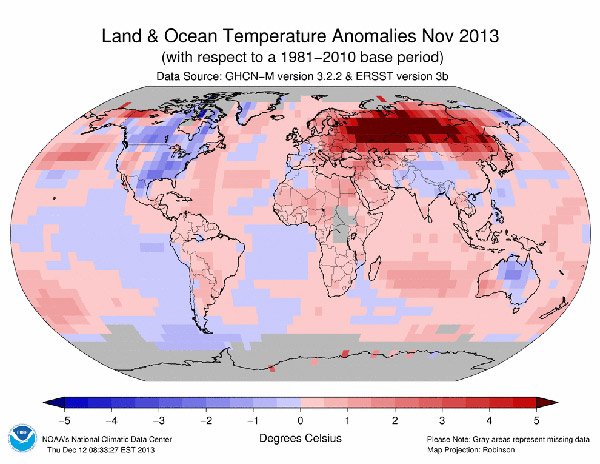 Last month was the warmest November on record, according to new analysis from the NOAA. Temperatures were 0.78 degrees Celsius (1.40 degrees Fahrenheit) above the average November in the 20th Century. Global temperatures are on the rise due to climate change caused primarily by burning fossil fuels, but also by deforestation and land-use change. While […]
Last month was the warmest November on record, according to new analysis from the NOAA. Temperatures were 0.78 degrees Celsius (1.40 degrees Fahrenheit) above the average November in the 20th Century. Global temperatures are on the rise due to climate change caused primarily by burning fossil fuels, but also by deforestation and land-use change. While […]
Top 10 Environmental Stories of 2013
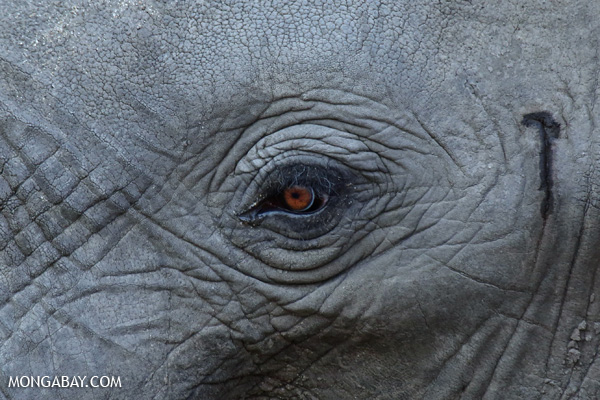 Also see our Top 10 HAPPY environmental stories of 2013. Elephant in South Africa. The poaching crisis in Africa is number six on our annual top ten list. Photo by: Rhett A. Butler. 1. Carbon concentrations hit 400ppm while the IPCC sets global carbon budget: For the first time since our appearance on Earth, carbon […]
Also see our Top 10 HAPPY environmental stories of 2013. Elephant in South Africa. The poaching crisis in Africa is number six on our annual top ten list. Photo by: Rhett A. Butler. 1. Carbon concentrations hit 400ppm while the IPCC sets global carbon budget: For the first time since our appearance on Earth, carbon […]
Philippines’ delegate calls out climate change deniers after Haiyan
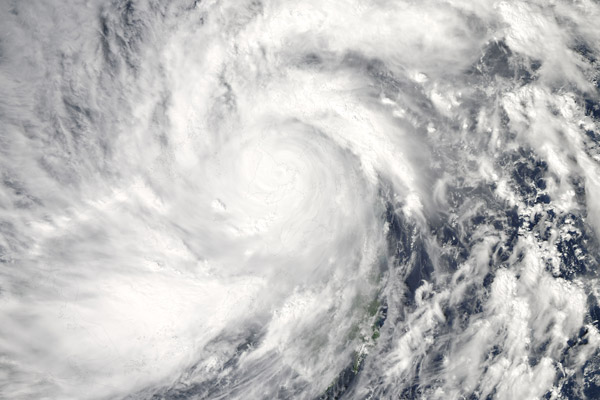 Yesterday, the Filipino delegate to the ongoing climate summit, Naderev ‘Yeb’ Saño, dared climate change deniers to take a hard look at what’s happening not just in the Philippines, but the whole world. Over the weekend, the Philippines was hit by what may have been the largest typhoon to ever make landfall—Typhoon Haiyan. Reports are […]
Yesterday, the Filipino delegate to the ongoing climate summit, Naderev ‘Yeb’ Saño, dared climate change deniers to take a hard look at what’s happening not just in the Philippines, but the whole world. Over the weekend, the Philippines was hit by what may have been the largest typhoon to ever make landfall—Typhoon Haiyan. Reports are […]
Delegate for the Philippines vows to stop eating at climate summit
 Following the devastation wrought by Typhoon Haiyan—which is arguably the strongest typhoon to ever make landfall—Filipino delegate, Naderev ‘Yeb’ Saño, has vowed to go on a fast at the UN Climate Summit that opened today in Warsaw, Poland. Saño made the vow during a powerful speech in which he said he would fast, “until we […]
Following the devastation wrought by Typhoon Haiyan—which is arguably the strongest typhoon to ever make landfall—Filipino delegate, Naderev ‘Yeb’ Saño, has vowed to go on a fast at the UN Climate Summit that opened today in Warsaw, Poland. Saño made the vow during a powerful speech in which he said he would fast, “until we […]
Climate change policy is just good economics
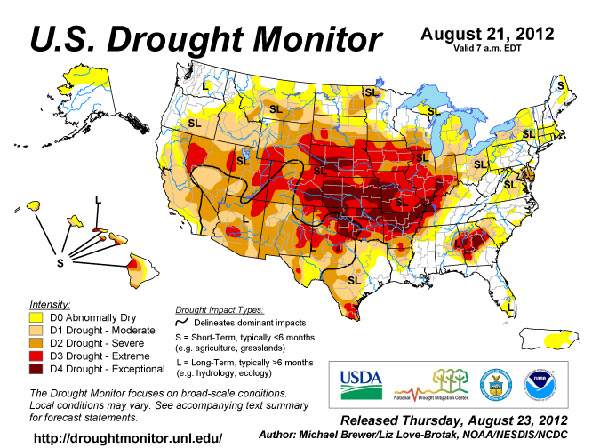 For the majority of the new century, Americans have largely stopped caring about the environment. In that time, America has suffered 9/11, two of the nation’s four longest wars, the deepest depression in 80 years, increased inequality, and incompetent or fractured leadership. There’s been a lot on the public mind. Our political and economic instability […]
For the majority of the new century, Americans have largely stopped caring about the environment. In that time, America has suffered 9/11, two of the nation’s four longest wars, the deepest depression in 80 years, increased inequality, and incompetent or fractured leadership. There’s been a lot on the public mind. Our political and economic instability […]
Worst drought in 30 years threatens millions in southern Africa with food insecurity
 Around 2 million people face food insecurity in northern Namibia and southern Angola as the worst regional drought in decades takes its toll, according to the UN. Two years of failed rains have pushed families into desperate conditions in a region already known for its desert-like conditions. In Namibia alone, experts estimate that over 100,000 […]
Around 2 million people face food insecurity in northern Namibia and southern Angola as the worst regional drought in decades takes its toll, according to the UN. Two years of failed rains have pushed families into desperate conditions in a region already known for its desert-like conditions. In Namibia alone, experts estimate that over 100,000 […]
Zoo races to save extreme butterfly from extinction
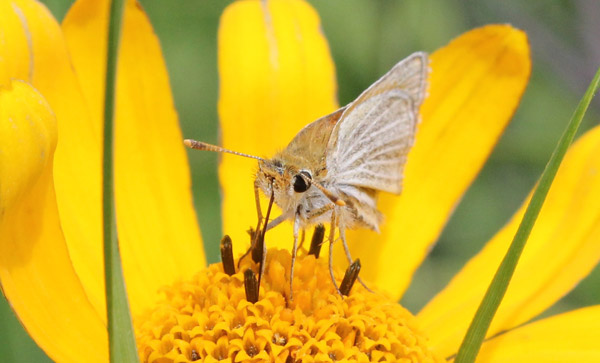 In a large room that used to house aquatic mammals at the Minnesota Zoo, Erik Runquist holds up a vial and says, “Here are its eggs.” I peer inside and see small specks, pale with a dot of brown at the top; they look like a single grain of cous cous or quinoa. Runquist explains […]
In a large room that used to house aquatic mammals at the Minnesota Zoo, Erik Runquist holds up a vial and says, “Here are its eggs.” I peer inside and see small specks, pale with a dot of brown at the top; they look like a single grain of cous cous or quinoa. Runquist explains […]
Climate change already pummeling U.S. according to government report
 State-by-state temperature records for 2012. Last year was the warmest on record for the continental U.S. going back to the late 19th Century. Courtesy of NOAA. Climate change is on the march across the U.S. according to a new draft report written by U.S. government scientists with input from 240 experts. It documents increasing and […]
State-by-state temperature records for 2012. Last year was the warmest on record for the continental U.S. going back to the late 19th Century. Courtesy of NOAA. Climate change is on the march across the U.S. according to a new draft report written by U.S. government scientists with input from 240 experts. It documents increasing and […]
Australia reels from record heatwave, fires
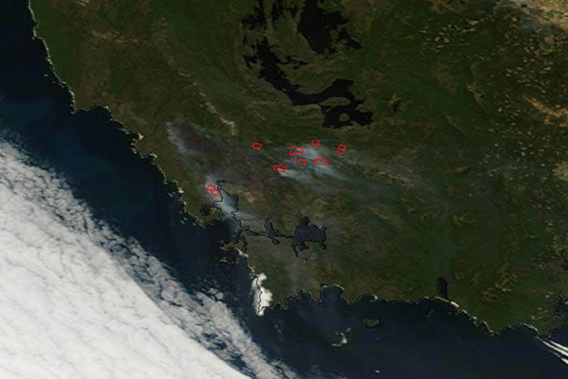 Expert: unprecedented heatwave ‘responding to the background warming trend’ Fires burning in Southwest Tasmania on January 7th. Image taken by the Moderate Resolution Imaging Spectroradiometer (MODIS) on NASA’s Terra satellite. Photo by: NASA. Yesterday Australia recorded its highest average temperature yet: 40.33 degrees Celsius (104.59 Fahrenheit). The nation has been sweltering under an unprecedented summer […]
Expert: unprecedented heatwave ‘responding to the background warming trend’ Fires burning in Southwest Tasmania on January 7th. Image taken by the Moderate Resolution Imaging Spectroradiometer (MODIS) on NASA’s Terra satellite. Photo by: NASA. Yesterday Australia recorded its highest average temperature yet: 40.33 degrees Celsius (104.59 Fahrenheit). The nation has been sweltering under an unprecedented summer […]
Climate Summit in Doha characterized by lack of ambition
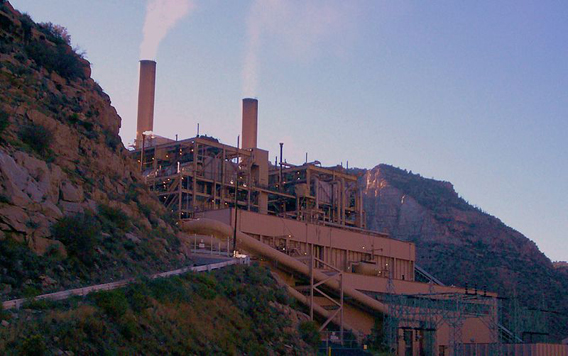 Coal-powered Castle Gate Power Plant in Ohio. Photo by: David Jolley. Ahead of the 18th United Nations Framework Convention on Climate Change (UNFCCC) in Doha, Qatar a variety of reports warned that the world was running out of time to avoid dangerous climate change, and that there was a widening gap between what nations have […]
Coal-powered Castle Gate Power Plant in Ohio. Photo by: David Jolley. Ahead of the 18th United Nations Framework Convention on Climate Change (UNFCCC) in Doha, Qatar a variety of reports warned that the world was running out of time to avoid dangerous climate change, and that there was a widening gap between what nations have […]
Illegal logging, mining worsened impact of Philippines’ killer typhoon
.568.jpg) Typhoon Bopha as seen by satellite on December 1st. Photo by: NASA MODIS Rapid Response System. According to Filipino officials, rampant illegal logging and mining were likely a part of the cause for the high casualty count from Category 5 Typhoon Bopha (Pablo), especially in the Compostela Valley where government officials had warned people to […]
Typhoon Bopha as seen by satellite on December 1st. Photo by: NASA MODIS Rapid Response System. According to Filipino officials, rampant illegal logging and mining were likely a part of the cause for the high casualty count from Category 5 Typhoon Bopha (Pablo), especially in the Compostela Valley where government officials had warned people to […]
World Bank: 4 degrees Celsius warming would be miserable
 Hurricane Sandy on October 25th in the Caribbean. Scientists say that climate change may have intensified Hurricane Sandy with its impact worsened by rising sea levels and increased evaporation from hotter marine waters. Recent studies predict that worsening climate change will bring more intense hurricanes. Photo by: NASA. A new report by the World Bank […]
Hurricane Sandy on October 25th in the Caribbean. Scientists say that climate change may have intensified Hurricane Sandy with its impact worsened by rising sea levels and increased evaporation from hotter marine waters. Recent studies predict that worsening climate change will bring more intense hurricanes. Photo by: NASA. A new report by the World Bank […]
Obama criticized for lack of urgency on climate change
 President Obama with Governor Chris Christie in New Jersey talking to victims of Hurricane Sandy. Photo by: Pete Souza. Following the devastation wrought by Hurricane Sandy—which many scientists say was likely worsened by climate change—and a long silence on the issue of global warming during the Presidential campaign, environmentalists yesterday were disappointed when re-elected President […]
President Obama with Governor Chris Christie in New Jersey talking to victims of Hurricane Sandy. Photo by: Pete Souza. Following the devastation wrought by Hurricane Sandy—which many scientists say was likely worsened by climate change—and a long silence on the issue of global warming during the Presidential campaign, environmentalists yesterday were disappointed when re-elected President […]
Obama breaks climate silence at press conference
 Hurricane Sandy storm surge on the New Jersey shore. Photo by: Master Sgt. Mark C. Olsen/U.S. Air Force/New Jersey National Guard. At a news conference today, a question by New York Times reporter Mark Landler pushed President Obama to speak at some length about climate change. In his answer, Obama re-iterated his acceptance of climate […]
Hurricane Sandy storm surge on the New Jersey shore. Photo by: Master Sgt. Mark C. Olsen/U.S. Air Force/New Jersey National Guard. At a news conference today, a question by New York Times reporter Mark Landler pushed President Obama to speak at some length about climate change. In his answer, Obama re-iterated his acceptance of climate […]
It’s not just Sandy: U.S. hit by record droughts, fires, and heatwaves in 2012
 Hurricane Sandy storm surge on the New Jersey shore. Photo by: Master Sgt. Mark C. Olsen/U.S. Air Force/New Jersey National Guard. As the devastation wrought by Hurricane Sandy—killing over 100 people and producing upwards of $50 billion in damage along the U.S. East Coast—has reignited a long-dormant conversation on climate change in the media, it’s […]
Hurricane Sandy storm surge on the New Jersey shore. Photo by: Master Sgt. Mark C. Olsen/U.S. Air Force/New Jersey National Guard. As the devastation wrought by Hurricane Sandy—killing over 100 people and producing upwards of $50 billion in damage along the U.S. East Coast—has reignited a long-dormant conversation on climate change in the media, it’s […]
From ‘fertilizer to fork’: food accounts for a quarter of the world’s greenhouse gas emissions
 Children stand in sweet potato fields in Indonesian New Guinea. A new report finds that poor and small-holding farmers are most vulnerable to the impacts of climate change. Photo by: Rhett A. Butler. Growing, transporting, refrigerating, and wasting food accounts for somewhere between 19-29 percent of the world’s greenhouse gas emissions in 2008, according to […]
Children stand in sweet potato fields in Indonesian New Guinea. A new report finds that poor and small-holding farmers are most vulnerable to the impacts of climate change. Photo by: Rhett A. Butler. Growing, transporting, refrigerating, and wasting food accounts for somewhere between 19-29 percent of the world’s greenhouse gas emissions in 2008, according to […]
New York Aquarium entirely ‘underwater’
 Update: New York Aquarium closed indefinitely The WCS New York Aquarium sits on the boardwalk of Coney Island. Photo by: David Shankbone. Hurricane Sandy, which brought storm surges that reportedly reached 14 feet to New York City, has put the Wildlife Conservation Society’s New York Aquarium “under water,” according to a statement from the organization. […]
Update: New York Aquarium closed indefinitely The WCS New York Aquarium sits on the boardwalk of Coney Island. Photo by: David Shankbone. Hurricane Sandy, which brought storm surges that reportedly reached 14 feet to New York City, has put the Wildlife Conservation Society’s New York Aquarium “under water,” according to a statement from the organization. […]
Hours before Hurricane Sandy hit, activists protested climate inaction in Times Square
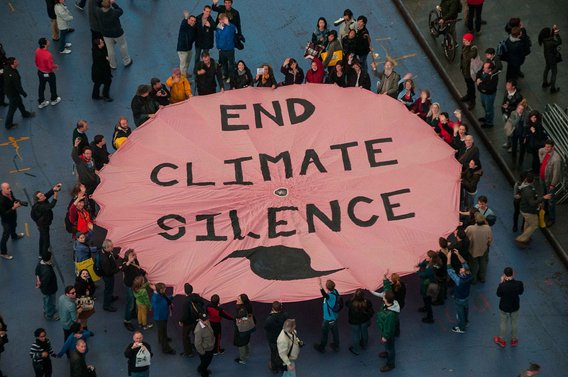 Activists protest climate silence in New York City ahead of Hurricane Sandy. Photo courtesy of 350.org. On Sunday, as Hurricane Sandy roared towards the coast of the Eastern U.S., activists took to the streets in New York City to highlight the issue of climate change. Activists organized by 350.org unfurled a huge parachute in Times […]
Activists protest climate silence in New York City ahead of Hurricane Sandy. Photo courtesy of 350.org. On Sunday, as Hurricane Sandy roared towards the coast of the Eastern U.S., activists took to the streets in New York City to highlight the issue of climate change. Activists organized by 350.org unfurled a huge parachute in Times […]
How climate change may be worsening Hurricane Sandy
 Hurricane Sandy near Jamaica. Sixty-nine people were killed in the Caribbean from the storm to date. Photo by: NOAA. While scientists are still debating some fundamental questions regarding hurricanes and climate change (such as: will climate change cause more or less hurricanes?), there’s no debating that a monster hurricane is now imperiling the U.S. East […]
Hurricane Sandy near Jamaica. Sixty-nine people were killed in the Caribbean from the storm to date. Photo by: NOAA. While scientists are still debating some fundamental questions regarding hurricanes and climate change (such as: will climate change cause more or less hurricanes?), there’s no debating that a monster hurricane is now imperiling the U.S. East […]
One in eight people suffer from malnutrition worldwide
 Girl in village in Madagascar. One of the world’s poorest countries, it has been estimated that about 70 percent of Malagasy people suffer from malnutrition. Photo by: Rhett A. Butler. In a world where technology has advanced to a point where I can instantly have a face-to-face conversation via online video with a friend in […]
Girl in village in Madagascar. One of the world’s poorest countries, it has been estimated that about 70 percent of Malagasy people suffer from malnutrition. Photo by: Rhett A. Butler. In a world where technology has advanced to a point where I can instantly have a face-to-face conversation via online video with a friend in […]
Over 70 percent of Americans: climate change worsening extreme weather
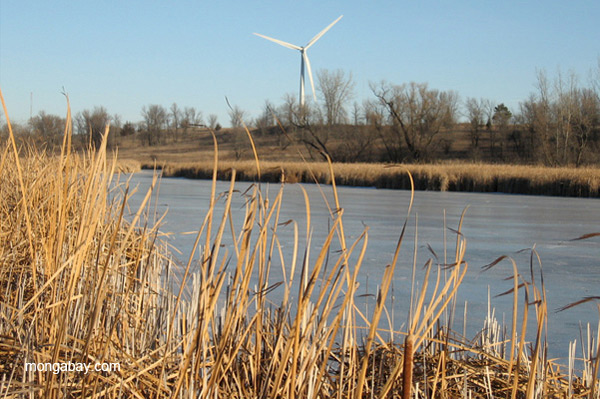 Wind turbine in Minnesota, U.S. Photo by: Tiffany Roufs. According to a new poll, 74 percent of Americans agree that climate change is impacting weather in the U.S., including 73 percent who agreed, strongly or somewhat, that climate change had exacerbated record high temperatures over the summer. The findings mean that a large majority of […]
Wind turbine in Minnesota, U.S. Photo by: Tiffany Roufs. According to a new poll, 74 percent of Americans agree that climate change is impacting weather in the U.S., including 73 percent who agreed, strongly or somewhat, that climate change had exacerbated record high temperatures over the summer. The findings mean that a large majority of […]
Arctic sea ice is ‘toast’ as old record shattered
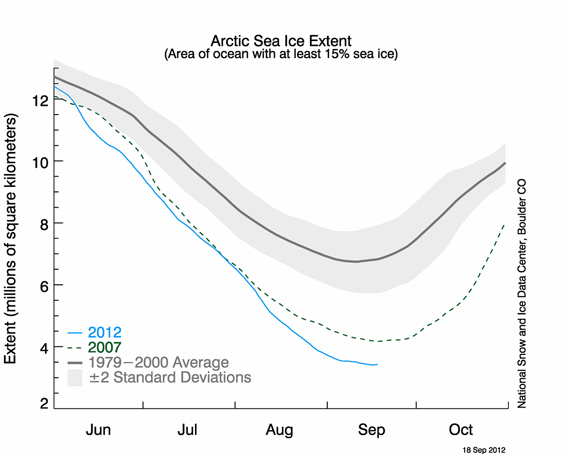 Sea ice extent hit a record low on August 26th, and then continued to decline another 700,000 square kilometers. Image courtesy of the U.S. National Snow and Ice Data Center (NSIDC). Some twenty days after breaking the record for the lowest sea ice extent, the Arctic sea ice has hit a new rock bottom and […]
Sea ice extent hit a record low on August 26th, and then continued to decline another 700,000 square kilometers. Image courtesy of the U.S. National Snow and Ice Data Center (NSIDC). Some twenty days after breaking the record for the lowest sea ice extent, the Arctic sea ice has hit a new rock bottom and […]
Sea ice falls to record low with over two weeks of melting left
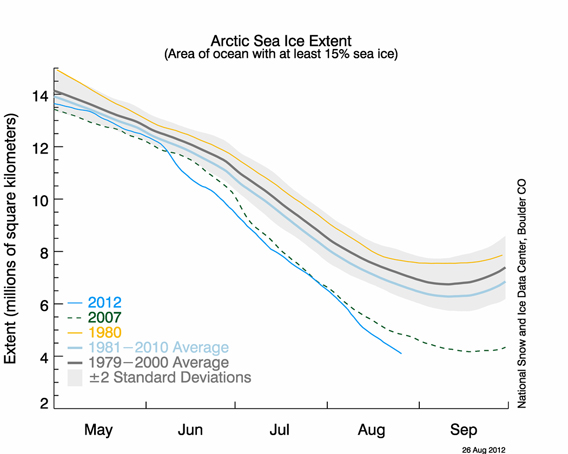 Sea ice extent hits record low on August 26th. Image courtesy of the U.S. National Snow and Ice Data Center (NSIDC). One of the most visible impacts of climate change—melting summer sea ice in the Arctic—just hit a new milestone. Scientists with the U.S. National Snow and Ice Data Center (NSIDC) have declared that this […]
Sea ice extent hits record low on August 26th. Image courtesy of the U.S. National Snow and Ice Data Center (NSIDC). One of the most visible impacts of climate change—melting summer sea ice in the Arctic—just hit a new milestone. Scientists with the U.S. National Snow and Ice Data Center (NSIDC) have declared that this […]
Climate change may be worsening impacts of killer frog disease
 Climate change, which is spawning more extreme temperatures variations worldwide, may be worsening the effects of a devastating fungal disease on the world’s amphibians, according to new research published in Nature Climate Change. Researchers found that frogs infected with the disease, known as chytridiomycosis, perished more rapidly when temperatures swung wildly. However scientists told the […]
Climate change, which is spawning more extreme temperatures variations worldwide, may be worsening the effects of a devastating fungal disease on the world’s amphibians, according to new research published in Nature Climate Change. Researchers found that frogs infected with the disease, known as chytridiomycosis, perished more rapidly when temperatures swung wildly. However scientists told the […]
Extreme heatwaves 50 to 100 times more likely due to climate change
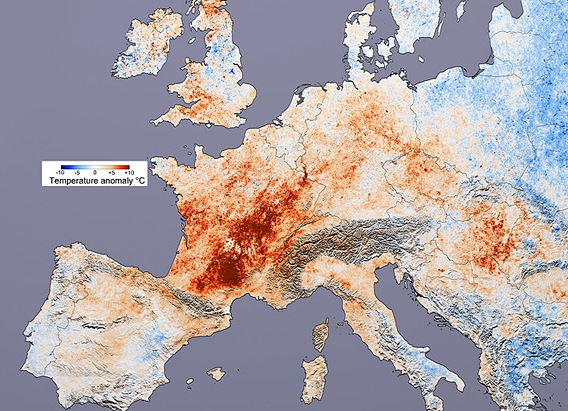 Hitting France especially hard, the Europe 2003 heatwave left tens of thousands of people dead. A new statistical analysis argues that climate change was the cause of this and other extreme summer heat events. Image by: NASA. A recent rise in deadly, debilitating, and expensive heatwaves was caused by climate change, argues a new statistical […]
Hitting France especially hard, the Europe 2003 heatwave left tens of thousands of people dead. A new statistical analysis argues that climate change was the cause of this and other extreme summer heat events. Image by: NASA. A recent rise in deadly, debilitating, and expensive heatwaves was caused by climate change, argues a new statistical […]
Featured video: climate change bringing on the extremes
Focusing on extreme weather events in the U.S. this summer, a new compilation video highlights the connection between climate change and increasing and worsening extremes, such as heatwaves, droughts, and floods. Includes interviews with several climatologists and other experts. While scientists say it is difficult to directly link a single weather event to climate change, […]
U.S. drought could set in motion global food crisis
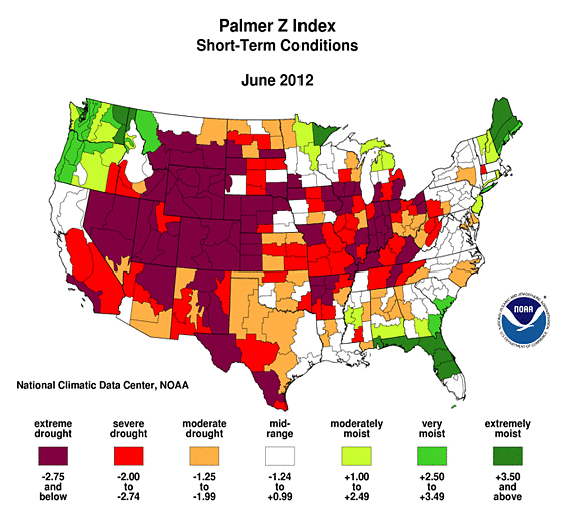 The U.S. is suffering drought levels not seen in over 50 years—and drawing comparisons to the Dust Bowl—with 56 percent of the contiguous U.S. in moderate to extreme drought. Some experts fear that the drought, and resulting hikes in food prices, could propel another global food crisis like those seen in 2008 and 2010. While […]
The U.S. is suffering drought levels not seen in over 50 years—and drawing comparisons to the Dust Bowl—with 56 percent of the contiguous U.S. in moderate to extreme drought. Some experts fear that the drought, and resulting hikes in food prices, could propel another global food crisis like those seen in 2008 and 2010. While […]
Deja vu: U.S. undergoes hottest 12 months on record…again and again
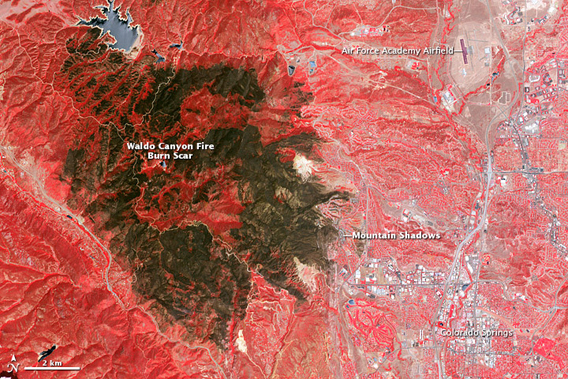 Fire scar from Waldo Canyon Fire in Colorado. Photo by: NASA. According to new data from the National Oceanic and Atmospheric Administration (NOAA)’s National Climatic Data Center, the last twelve months have been the warmest on record for the contiguous United States. This record, set between July 2011 through June 2012, beat the last consecutive […]
Fire scar from Waldo Canyon Fire in Colorado. Photo by: NASA. According to new data from the National Oceanic and Atmospheric Administration (NOAA)’s National Climatic Data Center, the last twelve months have been the warmest on record for the contiguous United States. This record, set between July 2011 through June 2012, beat the last consecutive […]
Climate change increased the probability of Texas drought, African famine, and other extreme weather
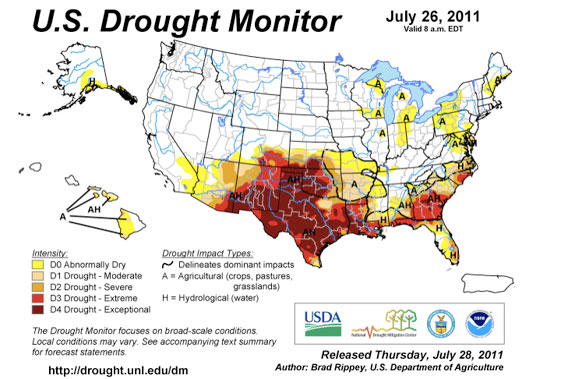 Map shows the level of drought and dryness across the US in July 2011. Map courtesy US Department of Agriculture. Click to enlarge. Climate change is here and its increasing the chances for crazy weather, according to scientists. A prestigious group of climatologists have released a landmark report that makes the dramatic point that climate […]
Map shows the level of drought and dryness across the US in July 2011. Map courtesy US Department of Agriculture. Click to enlarge. Climate change is here and its increasing the chances for crazy weather, according to scientists. A prestigious group of climatologists have released a landmark report that makes the dramatic point that climate […]
As U.S. sees record heat, extreme weather pummels 4 continents
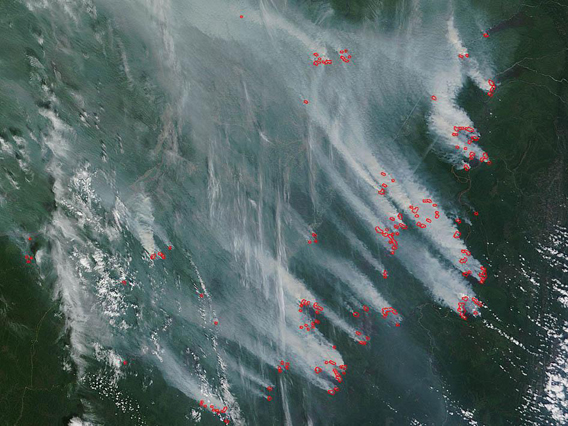 Over 30 fires burning in Eastern Russia yesterday. Photo by: NASA. It’s not only the U.S. that has experienced record-breaking extreme weather events recently, in the last couple months extreme weather has struck around the world with startling ferocity. In addition to the much-covered heatwaves, wildfires, and droughts in the U.S., killer floods struck India, […]
Over 30 fires burning in Eastern Russia yesterday. Photo by: NASA. It’s not only the U.S. that has experienced record-breaking extreme weather events recently, in the last couple months extreme weather has struck around the world with startling ferocity. In addition to the much-covered heatwaves, wildfires, and droughts in the U.S., killer floods struck India, […]
Scientist: ‘no doubt’ that climate change is playing a role in U.S. fires
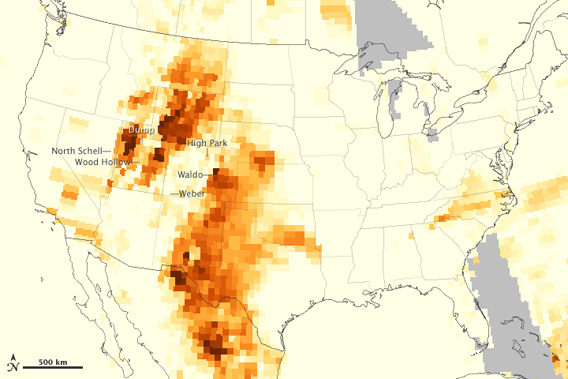 The map depicts the relative concentration of aerosols from wildlife smoke in the skies above the continental U.S. on June 26, 2012. Image by: NASA. A noted climate scientist says there is “no doubt” that climate change is “playing a role” in this year’s series of record fires in the western U.S. A massive wildfire […]
The map depicts the relative concentration of aerosols from wildlife smoke in the skies above the continental U.S. on June 26, 2012. Image by: NASA. A noted climate scientist says there is “no doubt” that climate change is “playing a role” in this year’s series of record fires in the western U.S. A massive wildfire […]
As Colorado and New Mexico burn, scientists say prepare for more
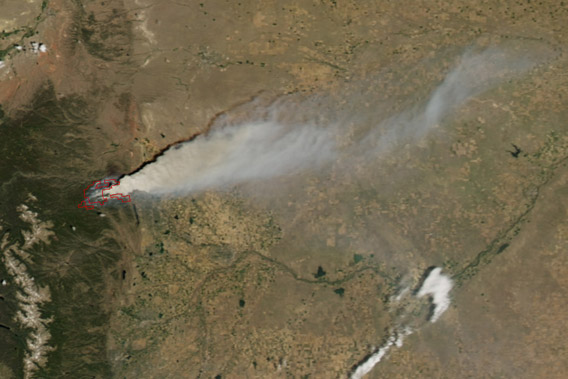 The High Park Fire in Colorado started on June 9th from a lightening strike and quickly expanded. This image is from June 10th, taken by Moderate Resolution Imaging Spectroradiometer (MODIS) on NASA’s Aqua satellite. Image courtesy of NASA. A massive wildlife in Colorado still burns after it has killed one person and damaged or destroyed […]
The High Park Fire in Colorado started on June 9th from a lightening strike and quickly expanded. This image is from June 10th, taken by Moderate Resolution Imaging Spectroradiometer (MODIS) on NASA’s Aqua satellite. Image courtesy of NASA. A massive wildlife in Colorado still burns after it has killed one person and damaged or destroyed […]
NASA image: New Mexico suffers record megafire
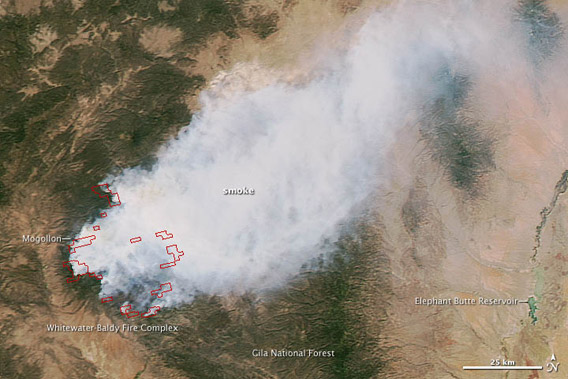 New Mexico’s biggest fire ever as seen on May 29th from NASA’s Aqua satellite. Photo by: NASA. To date, around 250,000 acres (101,000 hectares) of the Gila Forest in New Mexico have burned in the state’s largest fire ever recorded. Begun on May 16th due to lightning strikes, the unprecedented fire has likely been made […]
New Mexico’s biggest fire ever as seen on May 29th from NASA’s Aqua satellite. Photo by: NASA. To date, around 250,000 acres (101,000 hectares) of the Gila Forest in New Mexico have burned in the state’s largest fire ever recorded. Begun on May 16th due to lightning strikes, the unprecedented fire has likely been made […]
The vanishing Niger River imperils tourism and livelihoods in the desert
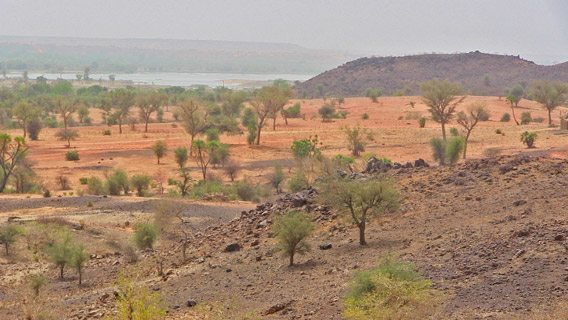 Contrary to conception, the Sahara Desert’s most common feature is really the Hamada, or stone plateaus and gravel plains, which cover over three quarters of its surface, and harbors at great distance the barely visible silhouette of the once-majestic Niger River. Photo by: Linda Leila Diatta. Severely affected by recent turmoil across its northern frontiers, […]
Contrary to conception, the Sahara Desert’s most common feature is really the Hamada, or stone plateaus and gravel plains, which cover over three quarters of its surface, and harbors at great distance the barely visible silhouette of the once-majestic Niger River. Photo by: Linda Leila Diatta. Severely affected by recent turmoil across its northern frontiers, […]
U.S. undergoes warmest 12 months yet
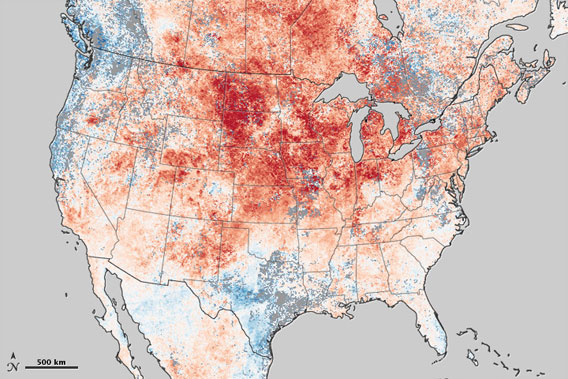 NASA map shows temperature anomalies from March 13-19, 2012 as compared to the same eight day period during the past 12 years. The map is based on data captured by the Moderate Resolution Imaging Spectroradiometer (MODIS) instrument on the Terra satellite. Click to enlarge. Americans would not be remiss in asking, “is it getting hot […]
NASA map shows temperature anomalies from March 13-19, 2012 as compared to the same eight day period during the past 12 years. The map is based on data captured by the Moderate Resolution Imaging Spectroradiometer (MODIS) instrument on the Terra satellite. Click to enlarge. Americans would not be remiss in asking, “is it getting hot […]
Pictures of the day: activists highlight personal impacts of climate change worldwide
 Activists hold a banner in front of a damaged coral reef in the vulnerable Marshall islands. Rising temperatures and increased CO2 uptake are raising the acidity of the ocean, which bleaches and ultimately may kill fragile coral reefs. Photo courtesy of: 350.org. On Saturday, people around the world gathered to highlight the varied impacts of […]
Activists hold a banner in front of a damaged coral reef in the vulnerable Marshall islands. Rising temperatures and increased CO2 uptake are raising the acidity of the ocean, which bleaches and ultimately may kill fragile coral reefs. Photo courtesy of: 350.org. On Saturday, people around the world gathered to highlight the varied impacts of […]
Thousands worldwide to “connect the dots” between climate change and extreme weather this weekend
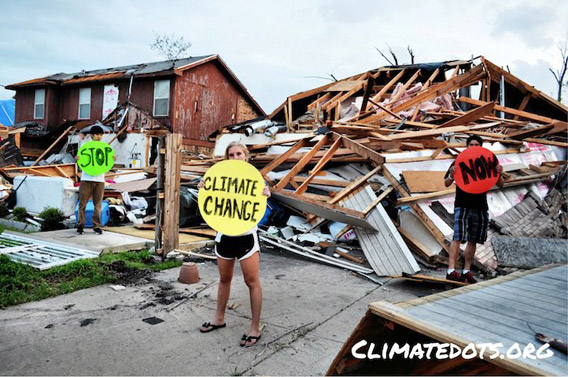 High school students in Texas connect the dots between climate change and tornados that appear earlier and earlier ever year. Scientists are just beginning to explore whether or not there is a connection between climate change and tornadoes. Photo courtesy of 350.org. On Saturday, May 5th vulnerable populations from the United States to Bangladesh will […]
High school students in Texas connect the dots between climate change and tornados that appear earlier and earlier ever year. Scientists are just beginning to explore whether or not there is a connection between climate change and tornadoes. Photo courtesy of 350.org. On Saturday, May 5th vulnerable populations from the United States to Bangladesh will […]
U.S. suffers warmest March, breaking over 15,000 record temperatures
 NASA map shows temperature anomalies from March 13-19, 2012 as compared to the same eight day period during the past 12 years. The map is based on data captured by the Moderate Resolution Imaging Spectroradiometer (MODIS) instrument on the Terra satellite. Click to enlarge. March was the warmest ever recorded in the U.S. with record-keeping […]
NASA map shows temperature anomalies from March 13-19, 2012 as compared to the same eight day period during the past 12 years. The map is based on data captured by the Moderate Resolution Imaging Spectroradiometer (MODIS) instrument on the Terra satellite. Click to enlarge. March was the warmest ever recorded in the U.S. with record-keeping […]
“Strong evidence” linking extreme heatwaves, floods, and droughts to climate change
 NASA map shows temperature anomalies from March 13-19, 2012 as compared to the same eight day period during the past 12 years based on data captured by the Moderate Resolution Imaging Spectroradiometer (MODIS) instrument on NASA’s Terra satellite. Click to enlarge. As North America recovers from what noted meteorologist Jeff Masters has called “the most […]
NASA map shows temperature anomalies from March 13-19, 2012 as compared to the same eight day period during the past 12 years based on data captured by the Moderate Resolution Imaging Spectroradiometer (MODIS) instrument on NASA’s Terra satellite. Click to enlarge. As North America recovers from what noted meteorologist Jeff Masters has called “the most […]
Tornado season likely to expand due to climate change
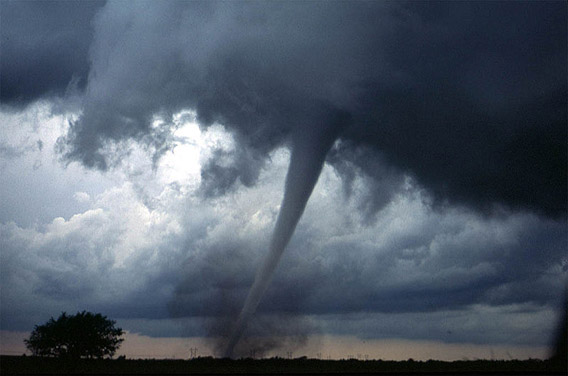
NASA: 2011 ninth warmest year yet
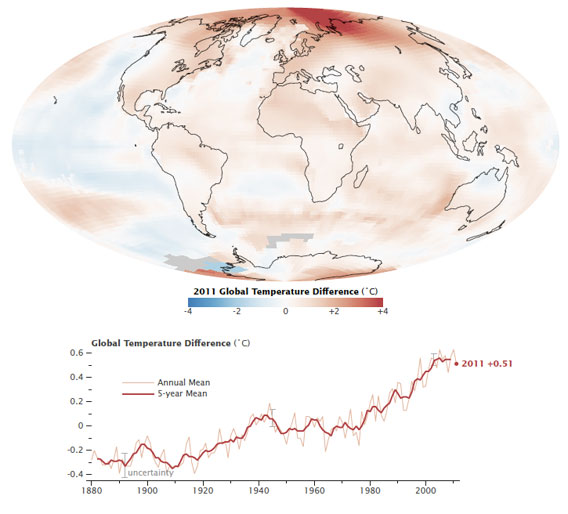 Despite being a strong La Niña year, which tends to be cooler than the average year, 2011 was the ninth warmest year on record and the warmest La Niña yet, according to a global temperature analysis by NASA. To date, nine of the world’s ten warmest years have occurred since 2000 according to data going […]
Despite being a strong La Niña year, which tends to be cooler than the average year, 2011 was the ninth warmest year on record and the warmest La Niña yet, according to a global temperature analysis by NASA. To date, nine of the world’s ten warmest years have occurred since 2000 according to data going […]
Climate change media coverage drops 20 percent in 2011
 Wind turbine in Morris, Minnesota. Photo by: Jeremy Hance. Global media reporting on climate change issues was down again last year, according to a new analysis from The Daily Climate. The news organization counted around 19,000 stories on climate issues during the year written by 7,140 journalists, falling 20 percent from 2010 levels. Coverage fell […]
Wind turbine in Morris, Minnesota. Photo by: Jeremy Hance. Global media reporting on climate change issues was down again last year, according to a new analysis from The Daily Climate. The news organization counted around 19,000 stories on climate issues during the year written by 7,140 journalists, falling 20 percent from 2010 levels. Coverage fell […]
Top 10 Environmental Stories of 2011
 Victories won by activists around the world tops our list of the big environmental stories of the year. In this photo: a young woman is placed in handcuffs and arrested for civil disobedience against the Keystone XL Pipeline in the U.S. In all, 1,252 people were arrested in the two week long action. Photo by: […]
Victories won by activists around the world tops our list of the big environmental stories of the year. In this photo: a young woman is placed in handcuffs and arrested for civil disobedience against the Keystone XL Pipeline in the U.S. In all, 1,252 people were arrested in the two week long action. Photo by: […]
Earth systems disruption: Does 2011 indicate the “new normal” of climate chaos and conflict?
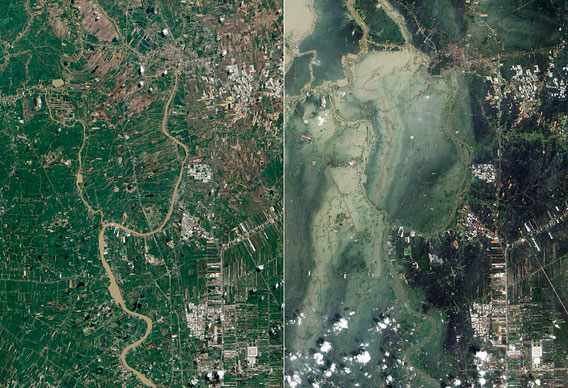 Before and after satellite images of flooding in Ayutthaya Province, Thailand. Photo by: NASA. The year 2011 has presented the world with a shocking increase in irregular weather and disasters linked to climate change. Just as the 2007 “big melt” of summer arctic sea ice sent scientists and environmentalists scrambling to re-evaluate the severity of […]
Before and after satellite images of flooding in Ayutthaya Province, Thailand. Photo by: NASA. The year 2011 has presented the world with a shocking increase in irregular weather and disasters linked to climate change. Just as the 2007 “big melt” of summer arctic sea ice sent scientists and environmentalists scrambling to re-evaluate the severity of […]
Texas loses half a billion trees to epic drought
 Map shows the level of drought and dryness across the US in July 2011. Map courtesy US Department of Agriculture. Click to enlarge. A punishing drought in Texas has not only damaged crops, killed cattle, and led to widespread fires, but has also killed off a significant portion of the state’s trees: between 100 and […]
Map shows the level of drought and dryness across the US in July 2011. Map courtesy US Department of Agriculture. Click to enlarge. A punishing drought in Texas has not only damaged crops, killed cattle, and led to widespread fires, but has also killed off a significant portion of the state’s trees: between 100 and […]
Philippines disaster may have been worsened by climate change, deforestation
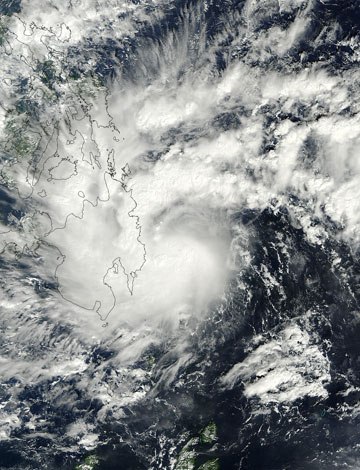 As the Philippines begins to bury more than a 1,000 disaster victims in mass graves, Philippine President Benigno Aquino has ordered an investigation into last weekend’s flash flood and landslide, including looking at the role of illegal logging. Officials have pointed to both climate change and vast deforestation as likely exacerbating the disaster. “We have […]
As the Philippines begins to bury more than a 1,000 disaster victims in mass graves, Philippine President Benigno Aquino has ordered an investigation into last weekend’s flash flood and landslide, including looking at the role of illegal logging. Officials have pointed to both climate change and vast deforestation as likely exacerbating the disaster. “We have […]
Is the Russian Forest Code a warning for Brazil?
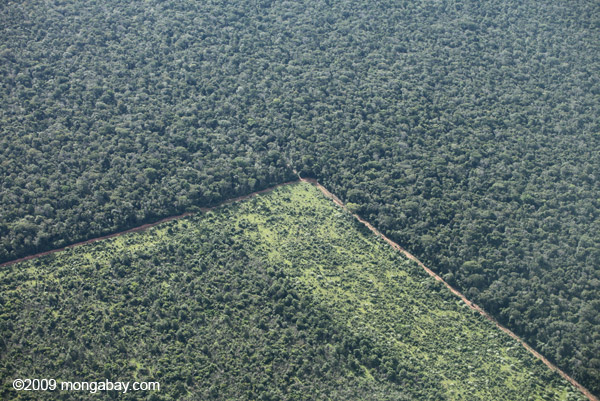 Recent deforestation in the Brazilian Amazon. Photo by: Rhett A. Butler. Brazil, which last week moved to reform its Forest Code, may find lessons in Russia’s revision of its forest law in 2007, say a pair of Russian scientists. The Brazilian Senate last week passed a bill that would relax some of forest provisions imposed […]
Recent deforestation in the Brazilian Amazon. Photo by: Rhett A. Butler. Brazil, which last week moved to reform its Forest Code, may find lessons in Russia’s revision of its forest law in 2007, say a pair of Russian scientists. The Brazilian Senate last week passed a bill that would relax some of forest provisions imposed […]
Another record breaker: 2011 warmest La Niña year ever
 The Turkana tribe of northern Kenya in East Africa are buffeted by constant drought and food insecurity, which recent research says may be worsening due to climate change. Photo by: Rhett A. Butler. As officials meet at the 17th UN Climate Summit in Durban, South Africa, the world continues to heat up. The UN World […]
The Turkana tribe of northern Kenya in East Africa are buffeted by constant drought and food insecurity, which recent research says may be worsening due to climate change. Photo by: Rhett A. Butler. As officials meet at the 17th UN Climate Summit in Durban, South Africa, the world continues to heat up. The UN World […]
Climate change already worsening weird, deadly, and expensive weather
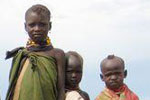 Unprecedented flooding in Thailand, torrential rains pummeling El Salvador, long-term and beyond-extreme drought in Texas, killer snowstorm in the eastern US—and that’s just the last month or so. Extreme weather worldwide appears to be both increasing in frequency and intensity, and a new report from the Intergovernmental Panel on Climate Change (IPCC) connects the dots […]
Unprecedented flooding in Thailand, torrential rains pummeling El Salvador, long-term and beyond-extreme drought in Texas, killer snowstorm in the eastern US—and that’s just the last month or so. Extreme weather worldwide appears to be both increasing in frequency and intensity, and a new report from the Intergovernmental Panel on Climate Change (IPCC) connects the dots […]
Chart: US suffers record drought
 Map shows the level of drought and dryness across the US. Map courtesy US Department of Agriculture. Click to enlarge. An exceptional drought is still scorching major parts of Texas, New Mexico, Oklahoma, and Louisiana. A new report from the National Drought Mitigation Center finds that over July, nearly 12 percent of the US saw […]
Map shows the level of drought and dryness across the US. Map courtesy US Department of Agriculture. Click to enlarge. An exceptional drought is still scorching major parts of Texas, New Mexico, Oklahoma, and Louisiana. A new report from the National Drought Mitigation Center finds that over July, nearly 12 percent of the US saw […]
Adaptation, justice and morality in a warming world
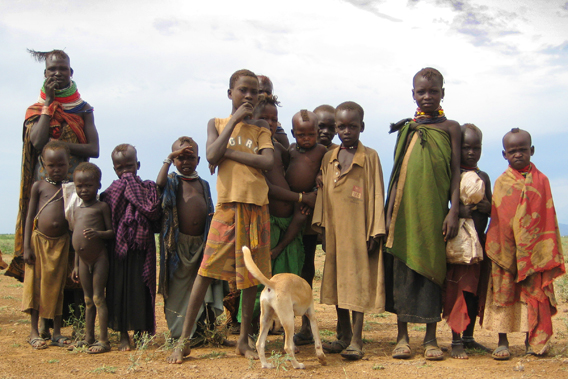 The Turkana people of northern Kenya are currently being hard hit by hunger and drought, which some experts say could have links to climate change. Observers have long warned that the world’s poor and marginalized will suffer the most from climate impacts even though they are the least responsible. Photo by: Rhett A. Butler. If […]
The Turkana people of northern Kenya are currently being hard hit by hunger and drought, which some experts say could have links to climate change. Observers have long warned that the world’s poor and marginalized will suffer the most from climate impacts even though they are the least responsible. Photo by: Rhett A. Butler. If […]
NASA Photos: beyond Mississippi flood, southern Africa sees record deluges
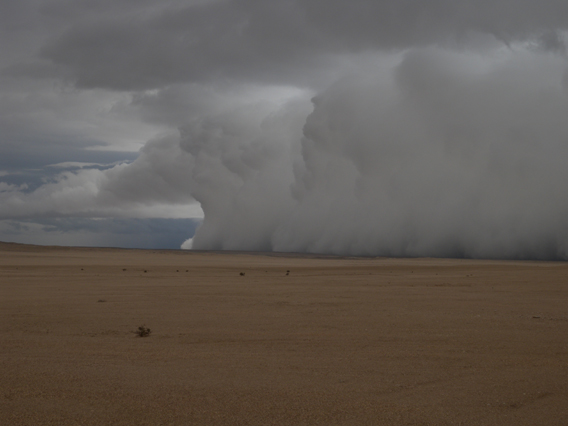 A shelf cloud passes over one of the driest regions on the African continent: the Namib desert. The shelf cloud is associated with a high-precipitation supercell thunderstorm. Photo courtesy of NASA. While record crests of the Mississippi River are creating havoc in the southern US, this is not the only region in the world facing […]
A shelf cloud passes over one of the driest regions on the African continent: the Namib desert. The shelf cloud is associated with a high-precipitation supercell thunderstorm. Photo courtesy of NASA. While record crests of the Mississippi River are creating havoc in the southern US, this is not the only region in the world facing […]
Burning up: warmer world means the rise of megafires
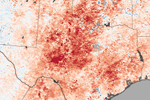 Megafires are likely both worsened by and contributing to global climate change, according to a new United Nations report. In the tropics, deforestation is playing a major role in creating giant, unprecedented fires. “These extraordinary conflagrations [or ‘megafires’] are unprecedented in the modern era for their deep and long-lasting social, economic, and environmental impacts,” reads […]
Megafires are likely both worsened by and contributing to global climate change, according to a new United Nations report. In the tropics, deforestation is playing a major role in creating giant, unprecedented fires. “These extraordinary conflagrations [or ‘megafires’] are unprecedented in the modern era for their deep and long-lasting social, economic, and environmental impacts,” reads […]
Are US floods, fires linked to climate change?
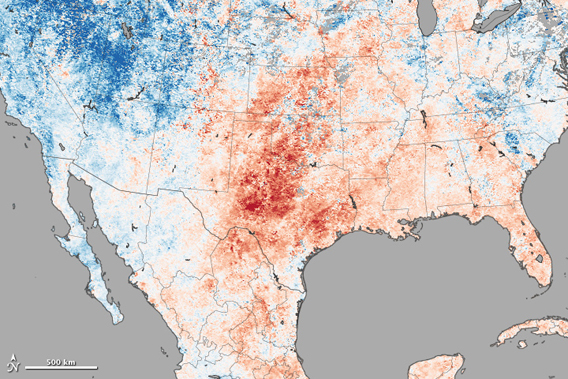 The short answer to the question of whether or not on-going floods in the US Midwest and fires in Texas are linked to a warming Earth is: maybe. The long answer, however, is that while it is difficult—some argue impossible—for scientists to link a single extreme weather event to climate change, climate models have long […]
The short answer to the question of whether or not on-going floods in the US Midwest and fires in Texas are linked to a warming Earth is: maybe. The long answer, however, is that while it is difficult—some argue impossible—for scientists to link a single extreme weather event to climate change, climate models have long […]
Food crisis 2011?: drought in China could push food prices even higher
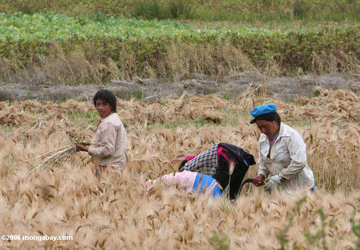 The UN’s Food and Agriculture Organization (FAO) has warned that a drought in China could devastate the nation’s winter wheat crop and further inflate food prices worldwide. Already, food prices hit a record high in January according to the FAO. Rising 3.4 percent since December, prices reached the highest point since tracking began in 1990. […]
The UN’s Food and Agriculture Organization (FAO) has warned that a drought in China could devastate the nation’s winter wheat crop and further inflate food prices worldwide. Already, food prices hit a record high in January according to the FAO. Rising 3.4 percent since December, prices reached the highest point since tracking began in 1990. […]
Numerous causes, including climate change, behind record food prices
Food prices hit a record high in January according to the UN’s Food and Agriculture Organization (FAO), threatening the world’s poor. Rising 3.4% since December, the FAO stated that prices reached the highest point since the agency began tracking food prices in 1990. Given the complexity of world markets and agriculture, experts have pointed to […]
Feeds: news | india | latam | brasil | indonesia
 Harrison Ford with orangutan in Years of Living Dangerously. Photo from: Years of Living Dangerously/Showtime. Although Showtime’s landmark new climate change series doesn’t premiere until Sunday, the network has released an edited version of the first episode of Years of Living Dangerously to the public (see below). The nine-part documentary series is being billed as […]
Harrison Ford with orangutan in Years of Living Dangerously. Photo from: Years of Living Dangerously/Showtime. Although Showtime’s landmark new climate change series doesn’t premiere until Sunday, the network has released an edited version of the first episode of Years of Living Dangerously to the public (see below). The nine-part documentary series is being billed as […] It’s not just melting glaciers and bizarrely-early Springs anymore; climate change is impacting every facet of human civilization from our ability to grow enough crops to our ability to get along with each other, according to a new 2,300-page report from the Intergovernmental Panel on Climate Change (IPCC). The massive report, from the Nobel Prize-winning […]
It’s not just melting glaciers and bizarrely-early Springs anymore; climate change is impacting every facet of human civilization from our ability to grow enough crops to our ability to get along with each other, according to a new 2,300-page report from the Intergovernmental Panel on Climate Change (IPCC). The massive report, from the Nobel Prize-winning […] Road flooded in Rondonia state, Brazil. Photo by: © GREENPEACE / Lunae Parracho. Environmentalists and scientists raised howls of protest when the Santo Antônio and Jirau Dams were proposed for the Western Amazon in Brazil, claiming among other issues that the dams would raise water levels on the Madeira River, potentially leading to catastrophic flooding. […]
Road flooded in Rondonia state, Brazil. Photo by: © GREENPEACE / Lunae Parracho. Environmentalists and scientists raised howls of protest when the Santo Antônio and Jirau Dams were proposed for the Western Amazon in Brazil, claiming among other issues that the dams would raise water levels on the Madeira River, potentially leading to catastrophic flooding. […] Temperatures in Alaska from January 23-30, 2014 as compared to same period average from 2001-2010. Image by: NASA. Alaska got California weather at the end of January, as displayed by a new map based on data by NASA’s Terra satellite’s Moderate Resolution Imaging Spectroradiometer (MODIS). The U.S. state experiences one of its warmest winter periods […]
Temperatures in Alaska from January 23-30, 2014 as compared to same period average from 2001-2010. Image by: NASA. Alaska got California weather at the end of January, as displayed by a new map based on data by NASA’s Terra satellite’s Moderate Resolution Imaging Spectroradiometer (MODIS). The U.S. state experiences one of its warmest winter periods […] Last month was the warmest November on record, according to new analysis from the NOAA. Temperatures were 0.78 degrees Celsius (1.40 degrees Fahrenheit) above the average November in the 20th Century. Global temperatures are on the rise due to climate change caused primarily by burning fossil fuels, but also by deforestation and land-use change. While […]
Last month was the warmest November on record, according to new analysis from the NOAA. Temperatures were 0.78 degrees Celsius (1.40 degrees Fahrenheit) above the average November in the 20th Century. Global temperatures are on the rise due to climate change caused primarily by burning fossil fuels, but also by deforestation and land-use change. While […] Also see our Top 10 HAPPY environmental stories of 2013. Elephant in South Africa. The poaching crisis in Africa is number six on our annual top ten list. Photo by: Rhett A. Butler. 1. Carbon concentrations hit 400ppm while the IPCC sets global carbon budget: For the first time since our appearance on Earth, carbon […]
Also see our Top 10 HAPPY environmental stories of 2013. Elephant in South Africa. The poaching crisis in Africa is number six on our annual top ten list. Photo by: Rhett A. Butler. 1. Carbon concentrations hit 400ppm while the IPCC sets global carbon budget: For the first time since our appearance on Earth, carbon […] Yesterday, the Filipino delegate to the ongoing climate summit, Naderev ‘Yeb’ Saño, dared climate change deniers to take a hard look at what’s happening not just in the Philippines, but the whole world. Over the weekend, the Philippines was hit by what may have been the largest typhoon to ever make landfall—Typhoon Haiyan. Reports are […]
Yesterday, the Filipino delegate to the ongoing climate summit, Naderev ‘Yeb’ Saño, dared climate change deniers to take a hard look at what’s happening not just in the Philippines, but the whole world. Over the weekend, the Philippines was hit by what may have been the largest typhoon to ever make landfall—Typhoon Haiyan. Reports are […] Following the devastation wrought by Typhoon Haiyan—which is arguably the strongest typhoon to ever make landfall—Filipino delegate, Naderev ‘Yeb’ Saño, has vowed to go on a fast at the UN Climate Summit that opened today in Warsaw, Poland. Saño made the vow during a powerful speech in which he said he would fast, “until we […]
Following the devastation wrought by Typhoon Haiyan—which is arguably the strongest typhoon to ever make landfall—Filipino delegate, Naderev ‘Yeb’ Saño, has vowed to go on a fast at the UN Climate Summit that opened today in Warsaw, Poland. Saño made the vow during a powerful speech in which he said he would fast, “until we […] For the majority of the new century, Americans have largely stopped caring about the environment. In that time, America has suffered 9/11, two of the nation’s four longest wars, the deepest depression in 80 years, increased inequality, and incompetent or fractured leadership. There’s been a lot on the public mind. Our political and economic instability […]
For the majority of the new century, Americans have largely stopped caring about the environment. In that time, America has suffered 9/11, two of the nation’s four longest wars, the deepest depression in 80 years, increased inequality, and incompetent or fractured leadership. There’s been a lot on the public mind. Our political and economic instability […] Around 2 million people face food insecurity in northern Namibia and southern Angola as the worst regional drought in decades takes its toll, according to the UN. Two years of failed rains have pushed families into desperate conditions in a region already known for its desert-like conditions. In Namibia alone, experts estimate that over 100,000 […]
Around 2 million people face food insecurity in northern Namibia and southern Angola as the worst regional drought in decades takes its toll, according to the UN. Two years of failed rains have pushed families into desperate conditions in a region already known for its desert-like conditions. In Namibia alone, experts estimate that over 100,000 […] In a large room that used to house aquatic mammals at the Minnesota Zoo, Erik Runquist holds up a vial and says, “Here are its eggs.” I peer inside and see small specks, pale with a dot of brown at the top; they look like a single grain of cous cous or quinoa. Runquist explains […]
In a large room that used to house aquatic mammals at the Minnesota Zoo, Erik Runquist holds up a vial and says, “Here are its eggs.” I peer inside and see small specks, pale with a dot of brown at the top; they look like a single grain of cous cous or quinoa. Runquist explains […] State-by-state temperature records for 2012. Last year was the warmest on record for the continental U.S. going back to the late 19th Century. Courtesy of NOAA. Climate change is on the march across the U.S. according to a new draft report written by U.S. government scientists with input from 240 experts. It documents increasing and […]
State-by-state temperature records for 2012. Last year was the warmest on record for the continental U.S. going back to the late 19th Century. Courtesy of NOAA. Climate change is on the march across the U.S. according to a new draft report written by U.S. government scientists with input from 240 experts. It documents increasing and […] Expert: unprecedented heatwave ‘responding to the background warming trend’ Fires burning in Southwest Tasmania on January 7th. Image taken by the Moderate Resolution Imaging Spectroradiometer (MODIS) on NASA’s Terra satellite. Photo by: NASA. Yesterday Australia recorded its highest average temperature yet: 40.33 degrees Celsius (104.59 Fahrenheit). The nation has been sweltering under an unprecedented summer […]
Expert: unprecedented heatwave ‘responding to the background warming trend’ Fires burning in Southwest Tasmania on January 7th. Image taken by the Moderate Resolution Imaging Spectroradiometer (MODIS) on NASA’s Terra satellite. Photo by: NASA. Yesterday Australia recorded its highest average temperature yet: 40.33 degrees Celsius (104.59 Fahrenheit). The nation has been sweltering under an unprecedented summer […] Coal-powered Castle Gate Power Plant in Ohio. Photo by: David Jolley. Ahead of the 18th United Nations Framework Convention on Climate Change (UNFCCC) in Doha, Qatar a variety of reports warned that the world was running out of time to avoid dangerous climate change, and that there was a widening gap between what nations have […]
Coal-powered Castle Gate Power Plant in Ohio. Photo by: David Jolley. Ahead of the 18th United Nations Framework Convention on Climate Change (UNFCCC) in Doha, Qatar a variety of reports warned that the world was running out of time to avoid dangerous climate change, and that there was a widening gap between what nations have […].568.jpg) Typhoon Bopha as seen by satellite on December 1st. Photo by: NASA MODIS Rapid Response System. According to Filipino officials, rampant illegal logging and mining were likely a part of the cause for the high casualty count from Category 5 Typhoon Bopha (Pablo), especially in the Compostela Valley where government officials had warned people to […]
Typhoon Bopha as seen by satellite on December 1st. Photo by: NASA MODIS Rapid Response System. According to Filipino officials, rampant illegal logging and mining were likely a part of the cause for the high casualty count from Category 5 Typhoon Bopha (Pablo), especially in the Compostela Valley where government officials had warned people to […] Hurricane Sandy on October 25th in the Caribbean. Scientists say that climate change may have intensified Hurricane Sandy with its impact worsened by rising sea levels and increased evaporation from hotter marine waters. Recent studies predict that worsening climate change will bring more intense hurricanes. Photo by: NASA. A new report by the World Bank […]
Hurricane Sandy on October 25th in the Caribbean. Scientists say that climate change may have intensified Hurricane Sandy with its impact worsened by rising sea levels and increased evaporation from hotter marine waters. Recent studies predict that worsening climate change will bring more intense hurricanes. Photo by: NASA. A new report by the World Bank […] President Obama with Governor Chris Christie in New Jersey talking to victims of Hurricane Sandy. Photo by: Pete Souza. Following the devastation wrought by Hurricane Sandy—which many scientists say was likely worsened by climate change—and a long silence on the issue of global warming during the Presidential campaign, environmentalists yesterday were disappointed when re-elected President […]
President Obama with Governor Chris Christie in New Jersey talking to victims of Hurricane Sandy. Photo by: Pete Souza. Following the devastation wrought by Hurricane Sandy—which many scientists say was likely worsened by climate change—and a long silence on the issue of global warming during the Presidential campaign, environmentalists yesterday were disappointed when re-elected President […] Hurricane Sandy storm surge on the New Jersey shore. Photo by: Master Sgt. Mark C. Olsen/U.S. Air Force/New Jersey National Guard. At a news conference today, a question by New York Times reporter Mark Landler pushed President Obama to speak at some length about climate change. In his answer, Obama re-iterated his acceptance of climate […]
Hurricane Sandy storm surge on the New Jersey shore. Photo by: Master Sgt. Mark C. Olsen/U.S. Air Force/New Jersey National Guard. At a news conference today, a question by New York Times reporter Mark Landler pushed President Obama to speak at some length about climate change. In his answer, Obama re-iterated his acceptance of climate […] Hurricane Sandy storm surge on the New Jersey shore. Photo by: Master Sgt. Mark C. Olsen/U.S. Air Force/New Jersey National Guard. As the devastation wrought by Hurricane Sandy—killing over 100 people and producing upwards of $50 billion in damage along the U.S. East Coast—has reignited a long-dormant conversation on climate change in the media, it’s […]
Hurricane Sandy storm surge on the New Jersey shore. Photo by: Master Sgt. Mark C. Olsen/U.S. Air Force/New Jersey National Guard. As the devastation wrought by Hurricane Sandy—killing over 100 people and producing upwards of $50 billion in damage along the U.S. East Coast—has reignited a long-dormant conversation on climate change in the media, it’s […] Children stand in sweet potato fields in Indonesian New Guinea. A new report finds that poor and small-holding farmers are most vulnerable to the impacts of climate change. Photo by: Rhett A. Butler. Growing, transporting, refrigerating, and wasting food accounts for somewhere between 19-29 percent of the world’s greenhouse gas emissions in 2008, according to […]
Children stand in sweet potato fields in Indonesian New Guinea. A new report finds that poor and small-holding farmers are most vulnerable to the impacts of climate change. Photo by: Rhett A. Butler. Growing, transporting, refrigerating, and wasting food accounts for somewhere between 19-29 percent of the world’s greenhouse gas emissions in 2008, according to […] Update: New York Aquarium closed indefinitely The WCS New York Aquarium sits on the boardwalk of Coney Island. Photo by: David Shankbone. Hurricane Sandy, which brought storm surges that reportedly reached 14 feet to New York City, has put the Wildlife Conservation Society’s New York Aquarium “under water,” according to a statement from the organization. […]
Update: New York Aquarium closed indefinitely The WCS New York Aquarium sits on the boardwalk of Coney Island. Photo by: David Shankbone. Hurricane Sandy, which brought storm surges that reportedly reached 14 feet to New York City, has put the Wildlife Conservation Society’s New York Aquarium “under water,” according to a statement from the organization. […] Activists protest climate silence in New York City ahead of Hurricane Sandy. Photo courtesy of 350.org. On Sunday, as Hurricane Sandy roared towards the coast of the Eastern U.S., activists took to the streets in New York City to highlight the issue of climate change. Activists organized by 350.org unfurled a huge parachute in Times […]
Activists protest climate silence in New York City ahead of Hurricane Sandy. Photo courtesy of 350.org. On Sunday, as Hurricane Sandy roared towards the coast of the Eastern U.S., activists took to the streets in New York City to highlight the issue of climate change. Activists organized by 350.org unfurled a huge parachute in Times […] Hurricane Sandy near Jamaica. Sixty-nine people were killed in the Caribbean from the storm to date. Photo by: NOAA. While scientists are still debating some fundamental questions regarding hurricanes and climate change (such as: will climate change cause more or less hurricanes?), there’s no debating that a monster hurricane is now imperiling the U.S. East […]
Hurricane Sandy near Jamaica. Sixty-nine people were killed in the Caribbean from the storm to date. Photo by: NOAA. While scientists are still debating some fundamental questions regarding hurricanes and climate change (such as: will climate change cause more or less hurricanes?), there’s no debating that a monster hurricane is now imperiling the U.S. East […] Girl in village in Madagascar. One of the world’s poorest countries, it has been estimated that about 70 percent of Malagasy people suffer from malnutrition. Photo by: Rhett A. Butler. In a world where technology has advanced to a point where I can instantly have a face-to-face conversation via online video with a friend in […]
Girl in village in Madagascar. One of the world’s poorest countries, it has been estimated that about 70 percent of Malagasy people suffer from malnutrition. Photo by: Rhett A. Butler. In a world where technology has advanced to a point where I can instantly have a face-to-face conversation via online video with a friend in […] Wind turbine in Minnesota, U.S. Photo by: Tiffany Roufs. According to a new poll, 74 percent of Americans agree that climate change is impacting weather in the U.S., including 73 percent who agreed, strongly or somewhat, that climate change had exacerbated record high temperatures over the summer. The findings mean that a large majority of […]
Wind turbine in Minnesota, U.S. Photo by: Tiffany Roufs. According to a new poll, 74 percent of Americans agree that climate change is impacting weather in the U.S., including 73 percent who agreed, strongly or somewhat, that climate change had exacerbated record high temperatures over the summer. The findings mean that a large majority of […] Sea ice extent hit a record low on August 26th, and then continued to decline another 700,000 square kilometers. Image courtesy of the U.S. National Snow and Ice Data Center (NSIDC). Some twenty days after breaking the record for the lowest sea ice extent, the Arctic sea ice has hit a new rock bottom and […]
Sea ice extent hit a record low on August 26th, and then continued to decline another 700,000 square kilometers. Image courtesy of the U.S. National Snow and Ice Data Center (NSIDC). Some twenty days after breaking the record for the lowest sea ice extent, the Arctic sea ice has hit a new rock bottom and […] Sea ice extent hits record low on August 26th. Image courtesy of the U.S. National Snow and Ice Data Center (NSIDC). One of the most visible impacts of climate change—melting summer sea ice in the Arctic—just hit a new milestone. Scientists with the U.S. National Snow and Ice Data Center (NSIDC) have declared that this […]
Sea ice extent hits record low on August 26th. Image courtesy of the U.S. National Snow and Ice Data Center (NSIDC). One of the most visible impacts of climate change—melting summer sea ice in the Arctic—just hit a new milestone. Scientists with the U.S. National Snow and Ice Data Center (NSIDC) have declared that this […] Climate change, which is spawning more extreme temperatures variations worldwide, may be worsening the effects of a devastating fungal disease on the world’s amphibians, according to new research published in Nature Climate Change. Researchers found that frogs infected with the disease, known as chytridiomycosis, perished more rapidly when temperatures swung wildly. However scientists told the […]
Climate change, which is spawning more extreme temperatures variations worldwide, may be worsening the effects of a devastating fungal disease on the world’s amphibians, according to new research published in Nature Climate Change. Researchers found that frogs infected with the disease, known as chytridiomycosis, perished more rapidly when temperatures swung wildly. However scientists told the […] Hitting France especially hard, the Europe 2003 heatwave left tens of thousands of people dead. A new statistical analysis argues that climate change was the cause of this and other extreme summer heat events. Image by: NASA. A recent rise in deadly, debilitating, and expensive heatwaves was caused by climate change, argues a new statistical […]
Hitting France especially hard, the Europe 2003 heatwave left tens of thousands of people dead. A new statistical analysis argues that climate change was the cause of this and other extreme summer heat events. Image by: NASA. A recent rise in deadly, debilitating, and expensive heatwaves was caused by climate change, argues a new statistical […] The U.S. is suffering drought levels not seen in over 50 years—and drawing comparisons to the Dust Bowl—with 56 percent of the contiguous U.S. in moderate to extreme drought. Some experts fear that the drought, and resulting hikes in food prices, could propel another global food crisis like those seen in 2008 and 2010. While […]
The U.S. is suffering drought levels not seen in over 50 years—and drawing comparisons to the Dust Bowl—with 56 percent of the contiguous U.S. in moderate to extreme drought. Some experts fear that the drought, and resulting hikes in food prices, could propel another global food crisis like those seen in 2008 and 2010. While […] Fire scar from Waldo Canyon Fire in Colorado. Photo by: NASA. According to new data from the National Oceanic and Atmospheric Administration (NOAA)’s National Climatic Data Center, the last twelve months have been the warmest on record for the contiguous United States. This record, set between July 2011 through June 2012, beat the last consecutive […]
Fire scar from Waldo Canyon Fire in Colorado. Photo by: NASA. According to new data from the National Oceanic and Atmospheric Administration (NOAA)’s National Climatic Data Center, the last twelve months have been the warmest on record for the contiguous United States. This record, set between July 2011 through June 2012, beat the last consecutive […] Map shows the level of drought and dryness across the US in July 2011. Map courtesy US Department of Agriculture. Click to enlarge. Climate change is here and its increasing the chances for crazy weather, according to scientists. A prestigious group of climatologists have released a landmark report that makes the dramatic point that climate […]
Map shows the level of drought and dryness across the US in July 2011. Map courtesy US Department of Agriculture. Click to enlarge. Climate change is here and its increasing the chances for crazy weather, according to scientists. A prestigious group of climatologists have released a landmark report that makes the dramatic point that climate […] Over 30 fires burning in Eastern Russia yesterday. Photo by: NASA. It’s not only the U.S. that has experienced record-breaking extreme weather events recently, in the last couple months extreme weather has struck around the world with startling ferocity. In addition to the much-covered heatwaves, wildfires, and droughts in the U.S., killer floods struck India, […]
Over 30 fires burning in Eastern Russia yesterday. Photo by: NASA. It’s not only the U.S. that has experienced record-breaking extreme weather events recently, in the last couple months extreme weather has struck around the world with startling ferocity. In addition to the much-covered heatwaves, wildfires, and droughts in the U.S., killer floods struck India, […] The map depicts the relative concentration of aerosols from wildlife smoke in the skies above the continental U.S. on June 26, 2012. Image by: NASA. A noted climate scientist says there is “no doubt” that climate change is “playing a role” in this year’s series of record fires in the western U.S. A massive wildfire […]
The map depicts the relative concentration of aerosols from wildlife smoke in the skies above the continental U.S. on June 26, 2012. Image by: NASA. A noted climate scientist says there is “no doubt” that climate change is “playing a role” in this year’s series of record fires in the western U.S. A massive wildfire […] The High Park Fire in Colorado started on June 9th from a lightening strike and quickly expanded. This image is from June 10th, taken by Moderate Resolution Imaging Spectroradiometer (MODIS) on NASA’s Aqua satellite. Image courtesy of NASA. A massive wildlife in Colorado still burns after it has killed one person and damaged or destroyed […]
The High Park Fire in Colorado started on June 9th from a lightening strike and quickly expanded. This image is from June 10th, taken by Moderate Resolution Imaging Spectroradiometer (MODIS) on NASA’s Aqua satellite. Image courtesy of NASA. A massive wildlife in Colorado still burns after it has killed one person and damaged or destroyed […] New Mexico’s biggest fire ever as seen on May 29th from NASA’s Aqua satellite. Photo by: NASA. To date, around 250,000 acres (101,000 hectares) of the Gila Forest in New Mexico have burned in the state’s largest fire ever recorded. Begun on May 16th due to lightning strikes, the unprecedented fire has likely been made […]
New Mexico’s biggest fire ever as seen on May 29th from NASA’s Aqua satellite. Photo by: NASA. To date, around 250,000 acres (101,000 hectares) of the Gila Forest in New Mexico have burned in the state’s largest fire ever recorded. Begun on May 16th due to lightning strikes, the unprecedented fire has likely been made […] Contrary to conception, the Sahara Desert’s most common feature is really the Hamada, or stone plateaus and gravel plains, which cover over three quarters of its surface, and harbors at great distance the barely visible silhouette of the once-majestic Niger River. Photo by: Linda Leila Diatta. Severely affected by recent turmoil across its northern frontiers, […]
Contrary to conception, the Sahara Desert’s most common feature is really the Hamada, or stone plateaus and gravel plains, which cover over three quarters of its surface, and harbors at great distance the barely visible silhouette of the once-majestic Niger River. Photo by: Linda Leila Diatta. Severely affected by recent turmoil across its northern frontiers, […] NASA map shows temperature anomalies from March 13-19, 2012 as compared to the same eight day period during the past 12 years. The map is based on data captured by the Moderate Resolution Imaging Spectroradiometer (MODIS) instrument on the Terra satellite. Click to enlarge. Americans would not be remiss in asking, “is it getting hot […]
NASA map shows temperature anomalies from March 13-19, 2012 as compared to the same eight day period during the past 12 years. The map is based on data captured by the Moderate Resolution Imaging Spectroradiometer (MODIS) instrument on the Terra satellite. Click to enlarge. Americans would not be remiss in asking, “is it getting hot […] Activists hold a banner in front of a damaged coral reef in the vulnerable Marshall islands. Rising temperatures and increased CO2 uptake are raising the acidity of the ocean, which bleaches and ultimately may kill fragile coral reefs. Photo courtesy of: 350.org. On Saturday, people around the world gathered to highlight the varied impacts of […]
Activists hold a banner in front of a damaged coral reef in the vulnerable Marshall islands. Rising temperatures and increased CO2 uptake are raising the acidity of the ocean, which bleaches and ultimately may kill fragile coral reefs. Photo courtesy of: 350.org. On Saturday, people around the world gathered to highlight the varied impacts of […] High school students in Texas connect the dots between climate change and tornados that appear earlier and earlier ever year. Scientists are just beginning to explore whether or not there is a connection between climate change and tornadoes. Photo courtesy of 350.org. On Saturday, May 5th vulnerable populations from the United States to Bangladesh will […]
High school students in Texas connect the dots between climate change and tornados that appear earlier and earlier ever year. Scientists are just beginning to explore whether or not there is a connection between climate change and tornadoes. Photo courtesy of 350.org. On Saturday, May 5th vulnerable populations from the United States to Bangladesh will […] NASA map shows temperature anomalies from March 13-19, 2012 as compared to the same eight day period during the past 12 years. The map is based on data captured by the Moderate Resolution Imaging Spectroradiometer (MODIS) instrument on the Terra satellite. Click to enlarge. March was the warmest ever recorded in the U.S. with record-keeping […]
NASA map shows temperature anomalies from March 13-19, 2012 as compared to the same eight day period during the past 12 years. The map is based on data captured by the Moderate Resolution Imaging Spectroradiometer (MODIS) instrument on the Terra satellite. Click to enlarge. March was the warmest ever recorded in the U.S. with record-keeping […] NASA map shows temperature anomalies from March 13-19, 2012 as compared to the same eight day period during the past 12 years based on data captured by the Moderate Resolution Imaging Spectroradiometer (MODIS) instrument on NASA’s Terra satellite. Click to enlarge. As North America recovers from what noted meteorologist Jeff Masters has called “the most […]
NASA map shows temperature anomalies from March 13-19, 2012 as compared to the same eight day period during the past 12 years based on data captured by the Moderate Resolution Imaging Spectroradiometer (MODIS) instrument on NASA’s Terra satellite. Click to enlarge. As North America recovers from what noted meteorologist Jeff Masters has called “the most […]
 Despite being a strong La Niña year, which tends to be cooler than the average year, 2011 was the ninth warmest year on record and the warmest La Niña yet, according to a global temperature analysis by NASA. To date, nine of the world’s ten warmest years have occurred since 2000 according to data going […]
Despite being a strong La Niña year, which tends to be cooler than the average year, 2011 was the ninth warmest year on record and the warmest La Niña yet, according to a global temperature analysis by NASA. To date, nine of the world’s ten warmest years have occurred since 2000 according to data going […] Wind turbine in Morris, Minnesota. Photo by: Jeremy Hance. Global media reporting on climate change issues was down again last year, according to a new analysis from The Daily Climate. The news organization counted around 19,000 stories on climate issues during the year written by 7,140 journalists, falling 20 percent from 2010 levels. Coverage fell […]
Wind turbine in Morris, Minnesota. Photo by: Jeremy Hance. Global media reporting on climate change issues was down again last year, according to a new analysis from The Daily Climate. The news organization counted around 19,000 stories on climate issues during the year written by 7,140 journalists, falling 20 percent from 2010 levels. Coverage fell […] Victories won by activists around the world tops our list of the big environmental stories of the year. In this photo: a young woman is placed in handcuffs and arrested for civil disobedience against the Keystone XL Pipeline in the U.S. In all, 1,252 people were arrested in the two week long action. Photo by: […]
Victories won by activists around the world tops our list of the big environmental stories of the year. In this photo: a young woman is placed in handcuffs and arrested for civil disobedience against the Keystone XL Pipeline in the U.S. In all, 1,252 people were arrested in the two week long action. Photo by: […] Before and after satellite images of flooding in Ayutthaya Province, Thailand. Photo by: NASA. The year 2011 has presented the world with a shocking increase in irregular weather and disasters linked to climate change. Just as the 2007 “big melt” of summer arctic sea ice sent scientists and environmentalists scrambling to re-evaluate the severity of […]
Before and after satellite images of flooding in Ayutthaya Province, Thailand. Photo by: NASA. The year 2011 has presented the world with a shocking increase in irregular weather and disasters linked to climate change. Just as the 2007 “big melt” of summer arctic sea ice sent scientists and environmentalists scrambling to re-evaluate the severity of […] Map shows the level of drought and dryness across the US in July 2011. Map courtesy US Department of Agriculture. Click to enlarge. A punishing drought in Texas has not only damaged crops, killed cattle, and led to widespread fires, but has also killed off a significant portion of the state’s trees: between 100 and […]
Map shows the level of drought and dryness across the US in July 2011. Map courtesy US Department of Agriculture. Click to enlarge. A punishing drought in Texas has not only damaged crops, killed cattle, and led to widespread fires, but has also killed off a significant portion of the state’s trees: between 100 and […] As the Philippines begins to bury more than a 1,000 disaster victims in mass graves, Philippine President Benigno Aquino has ordered an investigation into last weekend’s flash flood and landslide, including looking at the role of illegal logging. Officials have pointed to both climate change and vast deforestation as likely exacerbating the disaster. “We have […]
As the Philippines begins to bury more than a 1,000 disaster victims in mass graves, Philippine President Benigno Aquino has ordered an investigation into last weekend’s flash flood and landslide, including looking at the role of illegal logging. Officials have pointed to both climate change and vast deforestation as likely exacerbating the disaster. “We have […] Recent deforestation in the Brazilian Amazon. Photo by: Rhett A. Butler. Brazil, which last week moved to reform its Forest Code, may find lessons in Russia’s revision of its forest law in 2007, say a pair of Russian scientists. The Brazilian Senate last week passed a bill that would relax some of forest provisions imposed […]
Recent deforestation in the Brazilian Amazon. Photo by: Rhett A. Butler. Brazil, which last week moved to reform its Forest Code, may find lessons in Russia’s revision of its forest law in 2007, say a pair of Russian scientists. The Brazilian Senate last week passed a bill that would relax some of forest provisions imposed […] The Turkana tribe of northern Kenya in East Africa are buffeted by constant drought and food insecurity, which recent research says may be worsening due to climate change. Photo by: Rhett A. Butler. As officials meet at the 17th UN Climate Summit in Durban, South Africa, the world continues to heat up. The UN World […]
The Turkana tribe of northern Kenya in East Africa are buffeted by constant drought and food insecurity, which recent research says may be worsening due to climate change. Photo by: Rhett A. Butler. As officials meet at the 17th UN Climate Summit in Durban, South Africa, the world continues to heat up. The UN World […] Unprecedented flooding in Thailand, torrential rains pummeling El Salvador, long-term and beyond-extreme drought in Texas, killer snowstorm in the eastern US—and that’s just the last month or so. Extreme weather worldwide appears to be both increasing in frequency and intensity, and a new report from the Intergovernmental Panel on Climate Change (IPCC) connects the dots […]
Unprecedented flooding in Thailand, torrential rains pummeling El Salvador, long-term and beyond-extreme drought in Texas, killer snowstorm in the eastern US—and that’s just the last month or so. Extreme weather worldwide appears to be both increasing in frequency and intensity, and a new report from the Intergovernmental Panel on Climate Change (IPCC) connects the dots […] Map shows the level of drought and dryness across the US. Map courtesy US Department of Agriculture. Click to enlarge. An exceptional drought is still scorching major parts of Texas, New Mexico, Oklahoma, and Louisiana. A new report from the National Drought Mitigation Center finds that over July, nearly 12 percent of the US saw […]
Map shows the level of drought and dryness across the US. Map courtesy US Department of Agriculture. Click to enlarge. An exceptional drought is still scorching major parts of Texas, New Mexico, Oklahoma, and Louisiana. A new report from the National Drought Mitigation Center finds that over July, nearly 12 percent of the US saw […] The Turkana people of northern Kenya are currently being hard hit by hunger and drought, which some experts say could have links to climate change. Observers have long warned that the world’s poor and marginalized will suffer the most from climate impacts even though they are the least responsible. Photo by: Rhett A. Butler. If […]
The Turkana people of northern Kenya are currently being hard hit by hunger and drought, which some experts say could have links to climate change. Observers have long warned that the world’s poor and marginalized will suffer the most from climate impacts even though they are the least responsible. Photo by: Rhett A. Butler. If […] A shelf cloud passes over one of the driest regions on the African continent: the Namib desert. The shelf cloud is associated with a high-precipitation supercell thunderstorm. Photo courtesy of NASA. While record crests of the Mississippi River are creating havoc in the southern US, this is not the only region in the world facing […]
A shelf cloud passes over one of the driest regions on the African continent: the Namib desert. The shelf cloud is associated with a high-precipitation supercell thunderstorm. Photo courtesy of NASA. While record crests of the Mississippi River are creating havoc in the southern US, this is not the only region in the world facing […] Megafires are likely both worsened by and contributing to global climate change, according to a new United Nations report. In the tropics, deforestation is playing a major role in creating giant, unprecedented fires. “These extraordinary conflagrations [or ‘megafires’] are unprecedented in the modern era for their deep and long-lasting social, economic, and environmental impacts,” reads […]
Megafires are likely both worsened by and contributing to global climate change, according to a new United Nations report. In the tropics, deforestation is playing a major role in creating giant, unprecedented fires. “These extraordinary conflagrations [or ‘megafires’] are unprecedented in the modern era for their deep and long-lasting social, economic, and environmental impacts,” reads […] The short answer to the question of whether or not on-going floods in the US Midwest and fires in Texas are linked to a warming Earth is: maybe. The long answer, however, is that while it is difficult—some argue impossible—for scientists to link a single extreme weather event to climate change, climate models have long […]
The short answer to the question of whether or not on-going floods in the US Midwest and fires in Texas are linked to a warming Earth is: maybe. The long answer, however, is that while it is difficult—some argue impossible—for scientists to link a single extreme weather event to climate change, climate models have long […] The UN’s Food and Agriculture Organization (FAO) has warned that a drought in China could devastate the nation’s winter wheat crop and further inflate food prices worldwide. Already, food prices hit a record high in January according to the FAO. Rising 3.4 percent since December, prices reached the highest point since tracking began in 1990. […]
The UN’s Food and Agriculture Organization (FAO) has warned that a drought in China could devastate the nation’s winter wheat crop and further inflate food prices worldwide. Already, food prices hit a record high in January according to the FAO. Rising 3.4 percent since December, prices reached the highest point since tracking began in 1990. […]